Physiological Principles in Health and Social Care
VerifiedAdded on 2023/04/26
|32
|9123
|382
AI Summary
This document discusses the anatomical features of the skeletal system, principles of joints, functioning of body systems, and everyday functioning of the human body. It also highlights the interactive processes of various body systems which must be considered by healthcare professionals providing geriatric care.
Contribute Materials
Your contribution can guide someone’s learning journey. Share your
documents today.
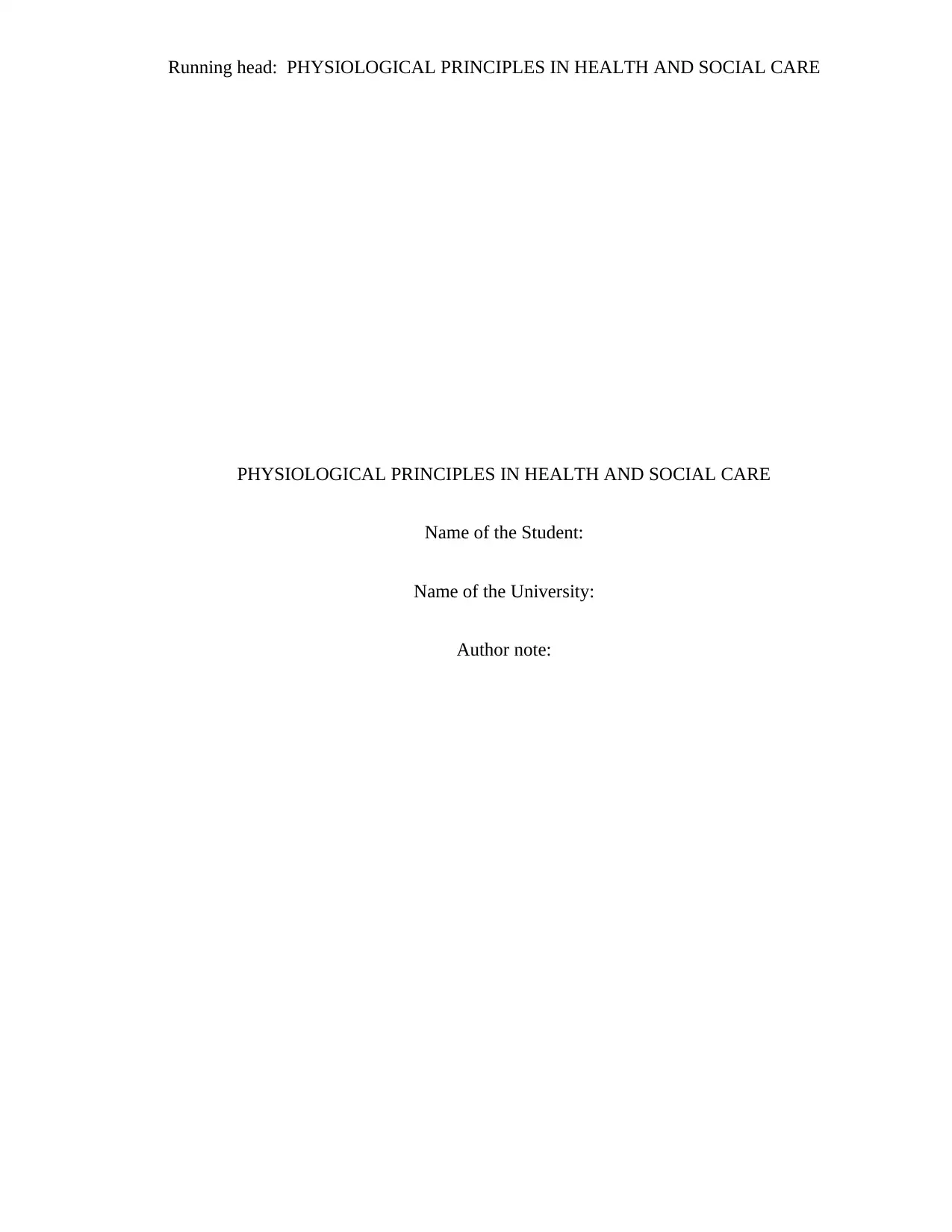
Running head: PHYSIOLOGICAL PRINCIPLES IN HEALTH AND SOCIAL CARE
PHYSIOLOGICAL PRINCIPLES IN HEALTH AND SOCIAL CARE
Name of the Student:
Name of the University:
Author note:
PHYSIOLOGICAL PRINCIPLES IN HEALTH AND SOCIAL CARE
Name of the Student:
Name of the University:
Author note:
Secure Best Marks with AI Grader
Need help grading? Try our AI Grader for instant feedback on your assignments.
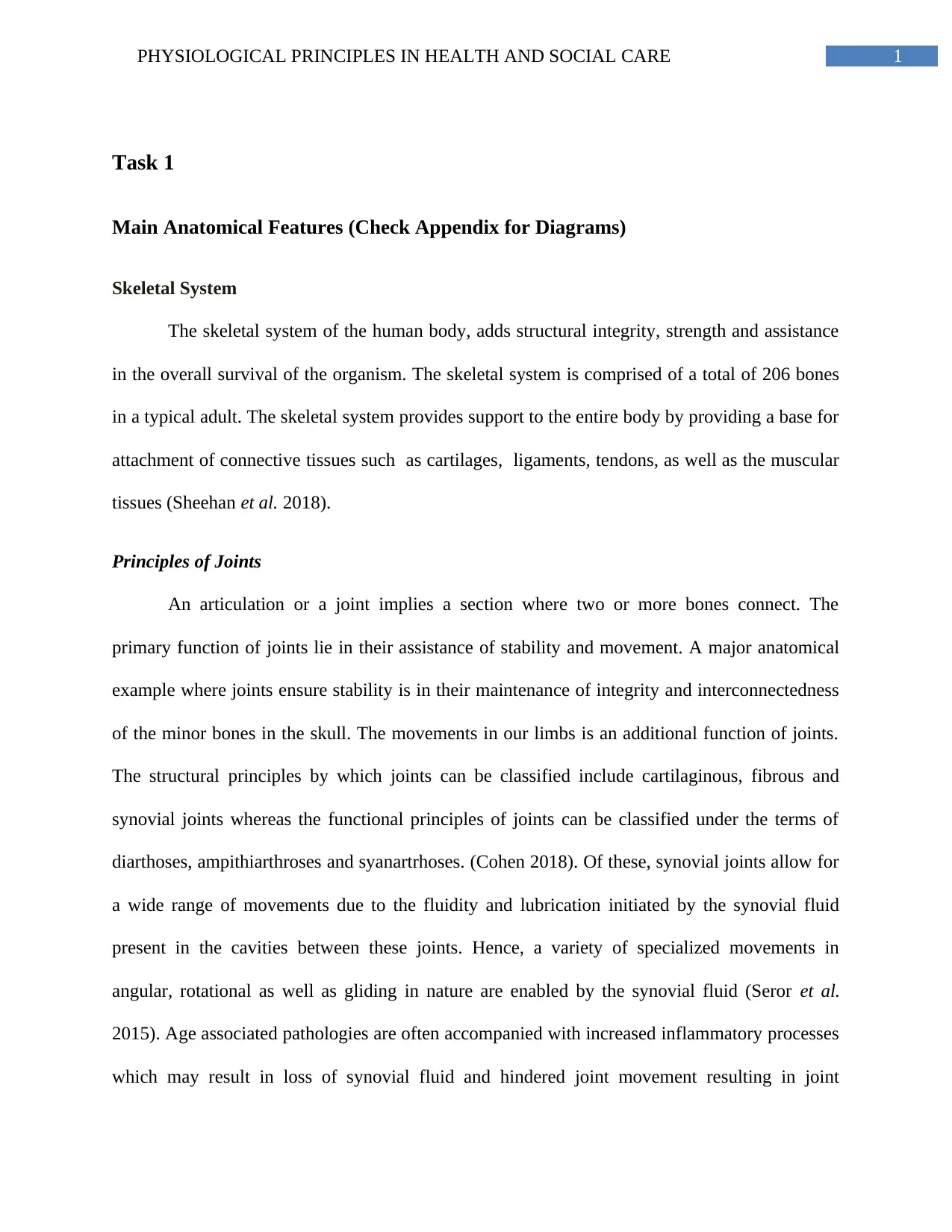
1PHYSIOLOGICAL PRINCIPLES IN HEALTH AND SOCIAL CARE
Task 1
Main Anatomical Features (Check Appendix for Diagrams)
Skeletal System
The skeletal system of the human body, adds structural integrity, strength and assistance
in the overall survival of the organism. The skeletal system is comprised of a total of 206 bones
in a typical adult. The skeletal system provides support to the entire body by providing a base for
attachment of connective tissues such as cartilages, ligaments, tendons, as well as the muscular
tissues (Sheehan et al. 2018).
Principles of Joints
An articulation or a joint implies a section where two or more bones connect. The
primary function of joints lie in their assistance of stability and movement. A major anatomical
example where joints ensure stability is in their maintenance of integrity and interconnectedness
of the minor bones in the skull. The movements in our limbs is an additional function of joints.
The structural principles by which joints can be classified include cartilaginous, fibrous and
synovial joints whereas the functional principles of joints can be classified under the terms of
diarthoses, ampithiarthroses and syanartrhoses. (Cohen 2018). Of these, synovial joints allow for
a wide range of movements due to the fluidity and lubrication initiated by the synovial fluid
present in the cavities between these joints. Hence, a variety of specialized movements in
angular, rotational as well as gliding in nature are enabled by the synovial fluid (Seror et al.
2015). Age associated pathologies are often accompanied with increased inflammatory processes
which may result in loss of synovial fluid and hindered joint movement resulting in joint
Task 1
Main Anatomical Features (Check Appendix for Diagrams)
Skeletal System
The skeletal system of the human body, adds structural integrity, strength and assistance
in the overall survival of the organism. The skeletal system is comprised of a total of 206 bones
in a typical adult. The skeletal system provides support to the entire body by providing a base for
attachment of connective tissues such as cartilages, ligaments, tendons, as well as the muscular
tissues (Sheehan et al. 2018).
Principles of Joints
An articulation or a joint implies a section where two or more bones connect. The
primary function of joints lie in their assistance of stability and movement. A major anatomical
example where joints ensure stability is in their maintenance of integrity and interconnectedness
of the minor bones in the skull. The movements in our limbs is an additional function of joints.
The structural principles by which joints can be classified include cartilaginous, fibrous and
synovial joints whereas the functional principles of joints can be classified under the terms of
diarthoses, ampithiarthroses and syanartrhoses. (Cohen 2018). Of these, synovial joints allow for
a wide range of movements due to the fluidity and lubrication initiated by the synovial fluid
present in the cavities between these joints. Hence, a variety of specialized movements in
angular, rotational as well as gliding in nature are enabled by the synovial fluid (Seror et al.
2015). Age associated pathologies are often accompanied with increased inflammatory processes
which may result in loss of synovial fluid and hindered joint movement resulting in joint
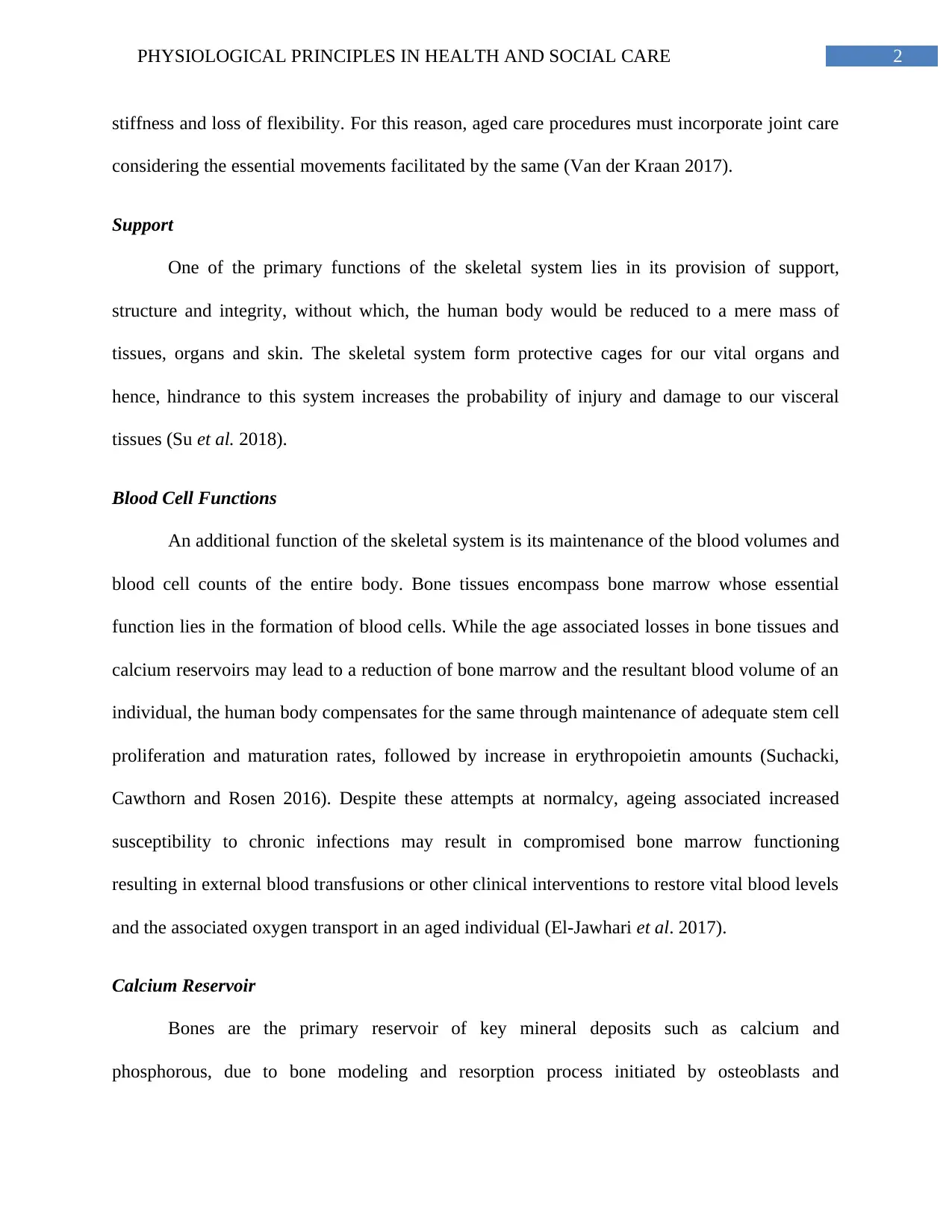
2PHYSIOLOGICAL PRINCIPLES IN HEALTH AND SOCIAL CARE
stiffness and loss of flexibility. For this reason, aged care procedures must incorporate joint care
considering the essential movements facilitated by the same (Van der Kraan 2017).
Support
One of the primary functions of the skeletal system lies in its provision of support,
structure and integrity, without which, the human body would be reduced to a mere mass of
tissues, organs and skin. The skeletal system form protective cages for our vital organs and
hence, hindrance to this system increases the probability of injury and damage to our visceral
tissues (Su et al. 2018).
Blood Cell Functions
An additional function of the skeletal system is its maintenance of the blood volumes and
blood cell counts of the entire body. Bone tissues encompass bone marrow whose essential
function lies in the formation of blood cells. While the age associated losses in bone tissues and
calcium reservoirs may lead to a reduction of bone marrow and the resultant blood volume of an
individual, the human body compensates for the same through maintenance of adequate stem cell
proliferation and maturation rates, followed by increase in erythropoietin amounts (Suchacki,
Cawthorn and Rosen 2016). Despite these attempts at normalcy, ageing associated increased
susceptibility to chronic infections may result in compromised bone marrow functioning
resulting in external blood transfusions or other clinical interventions to restore vital blood levels
and the associated oxygen transport in an aged individual (El-Jawhari et al. 2017).
Calcium Reservoir
Bones are the primary reservoir of key mineral deposits such as calcium and
phosphorous, due to bone modeling and resorption process initiated by osteoblasts and
stiffness and loss of flexibility. For this reason, aged care procedures must incorporate joint care
considering the essential movements facilitated by the same (Van der Kraan 2017).
Support
One of the primary functions of the skeletal system lies in its provision of support,
structure and integrity, without which, the human body would be reduced to a mere mass of
tissues, organs and skin. The skeletal system form protective cages for our vital organs and
hence, hindrance to this system increases the probability of injury and damage to our visceral
tissues (Su et al. 2018).
Blood Cell Functions
An additional function of the skeletal system is its maintenance of the blood volumes and
blood cell counts of the entire body. Bone tissues encompass bone marrow whose essential
function lies in the formation of blood cells. While the age associated losses in bone tissues and
calcium reservoirs may lead to a reduction of bone marrow and the resultant blood volume of an
individual, the human body compensates for the same through maintenance of adequate stem cell
proliferation and maturation rates, followed by increase in erythropoietin amounts (Suchacki,
Cawthorn and Rosen 2016). Despite these attempts at normalcy, ageing associated increased
susceptibility to chronic infections may result in compromised bone marrow functioning
resulting in external blood transfusions or other clinical interventions to restore vital blood levels
and the associated oxygen transport in an aged individual (El-Jawhari et al. 2017).
Calcium Reservoir
Bones are the primary reservoir of key mineral deposits such as calcium and
phosphorous, due to bone modeling and resorption process initiated by osteoblasts and
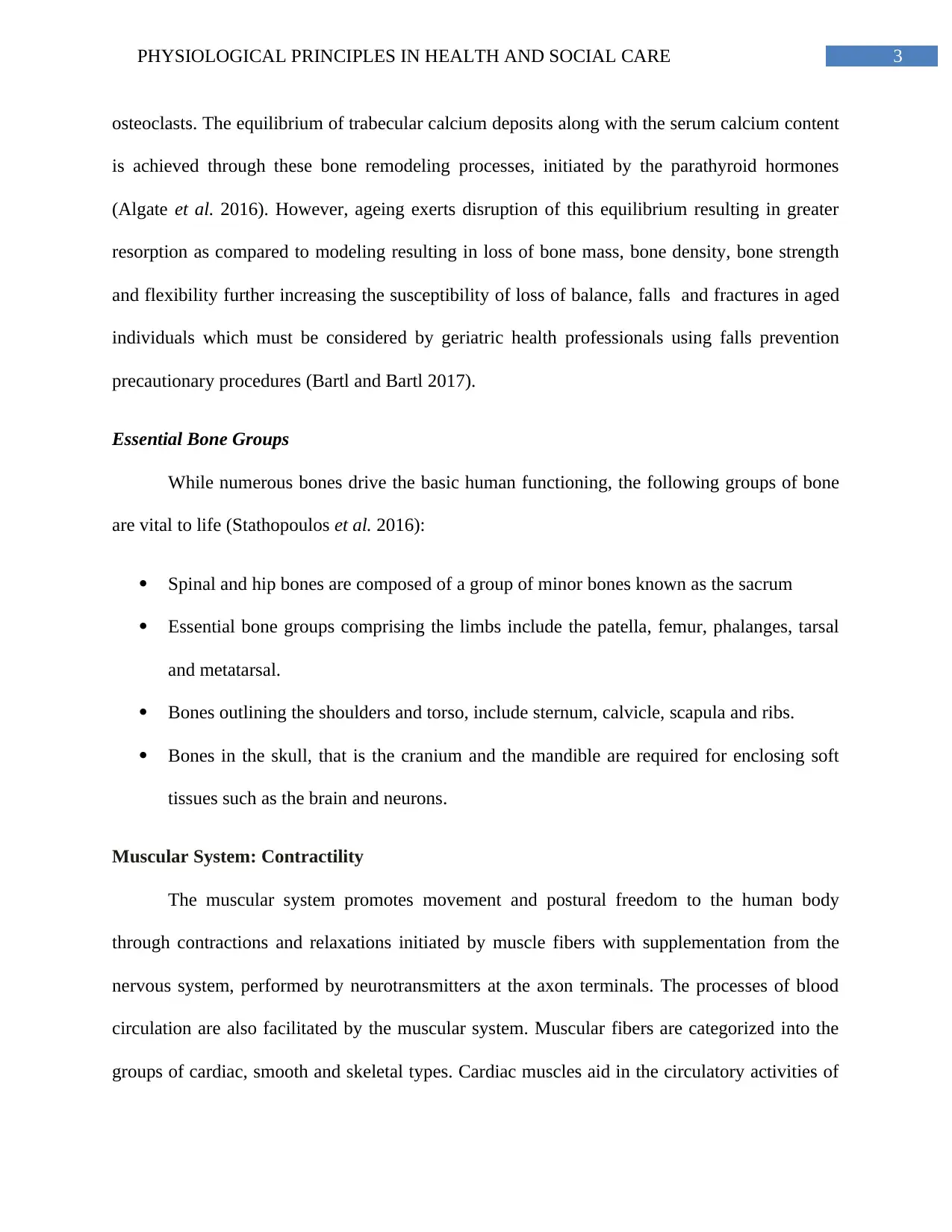
3PHYSIOLOGICAL PRINCIPLES IN HEALTH AND SOCIAL CARE
osteoclasts. The equilibrium of trabecular calcium deposits along with the serum calcium content
is achieved through these bone remodeling processes, initiated by the parathyroid hormones
(Algate et al. 2016). However, ageing exerts disruption of this equilibrium resulting in greater
resorption as compared to modeling resulting in loss of bone mass, bone density, bone strength
and flexibility further increasing the susceptibility of loss of balance, falls and fractures in aged
individuals which must be considered by geriatric health professionals using falls prevention
precautionary procedures (Bartl and Bartl 2017).
Essential Bone Groups
While numerous bones drive the basic human functioning, the following groups of bone
are vital to life (Stathopoulos et al. 2016):
Spinal and hip bones are composed of a group of minor bones known as the sacrum
Essential bone groups comprising the limbs include the patella, femur, phalanges, tarsal
and metatarsal.
Bones outlining the shoulders and torso, include sternum, calvicle, scapula and ribs.
Bones in the skull, that is the cranium and the mandible are required for enclosing soft
tissues such as the brain and neurons.
Muscular System: Contractility
The muscular system promotes movement and postural freedom to the human body
through contractions and relaxations initiated by muscle fibers with supplementation from the
nervous system, performed by neurotransmitters at the axon terminals. The processes of blood
circulation are also facilitated by the muscular system. Muscular fibers are categorized into the
groups of cardiac, smooth and skeletal types. Cardiac muscles aid in the circulatory activities of
osteoclasts. The equilibrium of trabecular calcium deposits along with the serum calcium content
is achieved through these bone remodeling processes, initiated by the parathyroid hormones
(Algate et al. 2016). However, ageing exerts disruption of this equilibrium resulting in greater
resorption as compared to modeling resulting in loss of bone mass, bone density, bone strength
and flexibility further increasing the susceptibility of loss of balance, falls and fractures in aged
individuals which must be considered by geriatric health professionals using falls prevention
precautionary procedures (Bartl and Bartl 2017).
Essential Bone Groups
While numerous bones drive the basic human functioning, the following groups of bone
are vital to life (Stathopoulos et al. 2016):
Spinal and hip bones are composed of a group of minor bones known as the sacrum
Essential bone groups comprising the limbs include the patella, femur, phalanges, tarsal
and metatarsal.
Bones outlining the shoulders and torso, include sternum, calvicle, scapula and ribs.
Bones in the skull, that is the cranium and the mandible are required for enclosing soft
tissues such as the brain and neurons.
Muscular System: Contractility
The muscular system promotes movement and postural freedom to the human body
through contractions and relaxations initiated by muscle fibers with supplementation from the
nervous system, performed by neurotransmitters at the axon terminals. The processes of blood
circulation are also facilitated by the muscular system. Muscular fibers are categorized into the
groups of cardiac, smooth and skeletal types. Cardiac muscles aid in the circulatory activities of
Secure Best Marks with AI Grader
Need help grading? Try our AI Grader for instant feedback on your assignments.
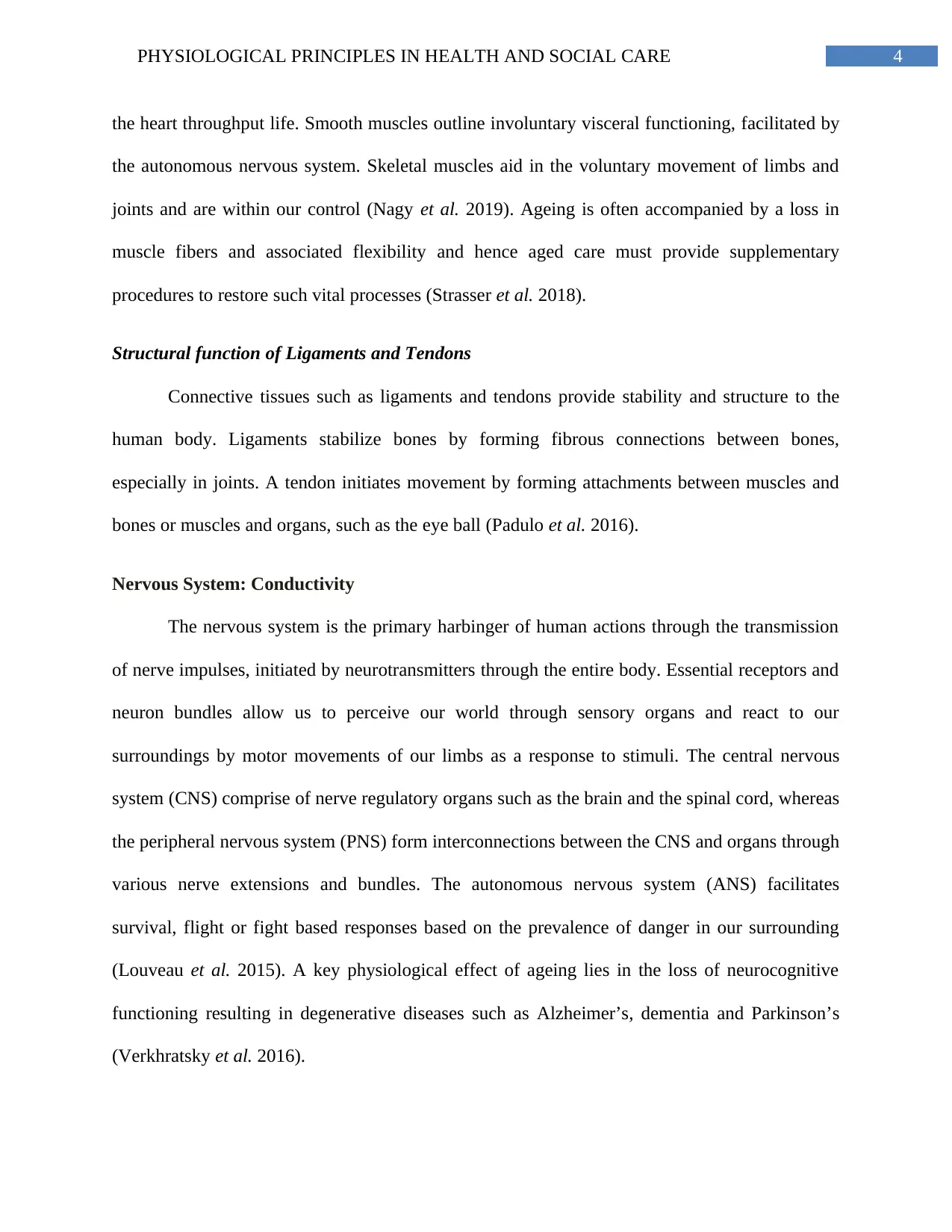
4PHYSIOLOGICAL PRINCIPLES IN HEALTH AND SOCIAL CARE
the heart throughput life. Smooth muscles outline involuntary visceral functioning, facilitated by
the autonomous nervous system. Skeletal muscles aid in the voluntary movement of limbs and
joints and are within our control (Nagy et al. 2019). Ageing is often accompanied by a loss in
muscle fibers and associated flexibility and hence aged care must provide supplementary
procedures to restore such vital processes (Strasser et al. 2018).
Structural function of Ligaments and Tendons
Connective tissues such as ligaments and tendons provide stability and structure to the
human body. Ligaments stabilize bones by forming fibrous connections between bones,
especially in joints. A tendon initiates movement by forming attachments between muscles and
bones or muscles and organs, such as the eye ball (Padulo et al. 2016).
Nervous System: Conductivity
The nervous system is the primary harbinger of human actions through the transmission
of nerve impulses, initiated by neurotransmitters through the entire body. Essential receptors and
neuron bundles allow us to perceive our world through sensory organs and react to our
surroundings by motor movements of our limbs as a response to stimuli. The central nervous
system (CNS) comprise of nerve regulatory organs such as the brain and the spinal cord, whereas
the peripheral nervous system (PNS) form interconnections between the CNS and organs through
various nerve extensions and bundles. The autonomous nervous system (ANS) facilitates
survival, flight or fight based responses based on the prevalence of danger in our surrounding
(Louveau et al. 2015). A key physiological effect of ageing lies in the loss of neurocognitive
functioning resulting in degenerative diseases such as Alzheimer’s, dementia and Parkinson’s
(Verkhratsky et al. 2016).
the heart throughput life. Smooth muscles outline involuntary visceral functioning, facilitated by
the autonomous nervous system. Skeletal muscles aid in the voluntary movement of limbs and
joints and are within our control (Nagy et al. 2019). Ageing is often accompanied by a loss in
muscle fibers and associated flexibility and hence aged care must provide supplementary
procedures to restore such vital processes (Strasser et al. 2018).
Structural function of Ligaments and Tendons
Connective tissues such as ligaments and tendons provide stability and structure to the
human body. Ligaments stabilize bones by forming fibrous connections between bones,
especially in joints. A tendon initiates movement by forming attachments between muscles and
bones or muscles and organs, such as the eye ball (Padulo et al. 2016).
Nervous System: Conductivity
The nervous system is the primary harbinger of human actions through the transmission
of nerve impulses, initiated by neurotransmitters through the entire body. Essential receptors and
neuron bundles allow us to perceive our world through sensory organs and react to our
surroundings by motor movements of our limbs as a response to stimuli. The central nervous
system (CNS) comprise of nerve regulatory organs such as the brain and the spinal cord, whereas
the peripheral nervous system (PNS) form interconnections between the CNS and organs through
various nerve extensions and bundles. The autonomous nervous system (ANS) facilitates
survival, flight or fight based responses based on the prevalence of danger in our surrounding
(Louveau et al. 2015). A key physiological effect of ageing lies in the loss of neurocognitive
functioning resulting in degenerative diseases such as Alzheimer’s, dementia and Parkinson’s
(Verkhratsky et al. 2016).
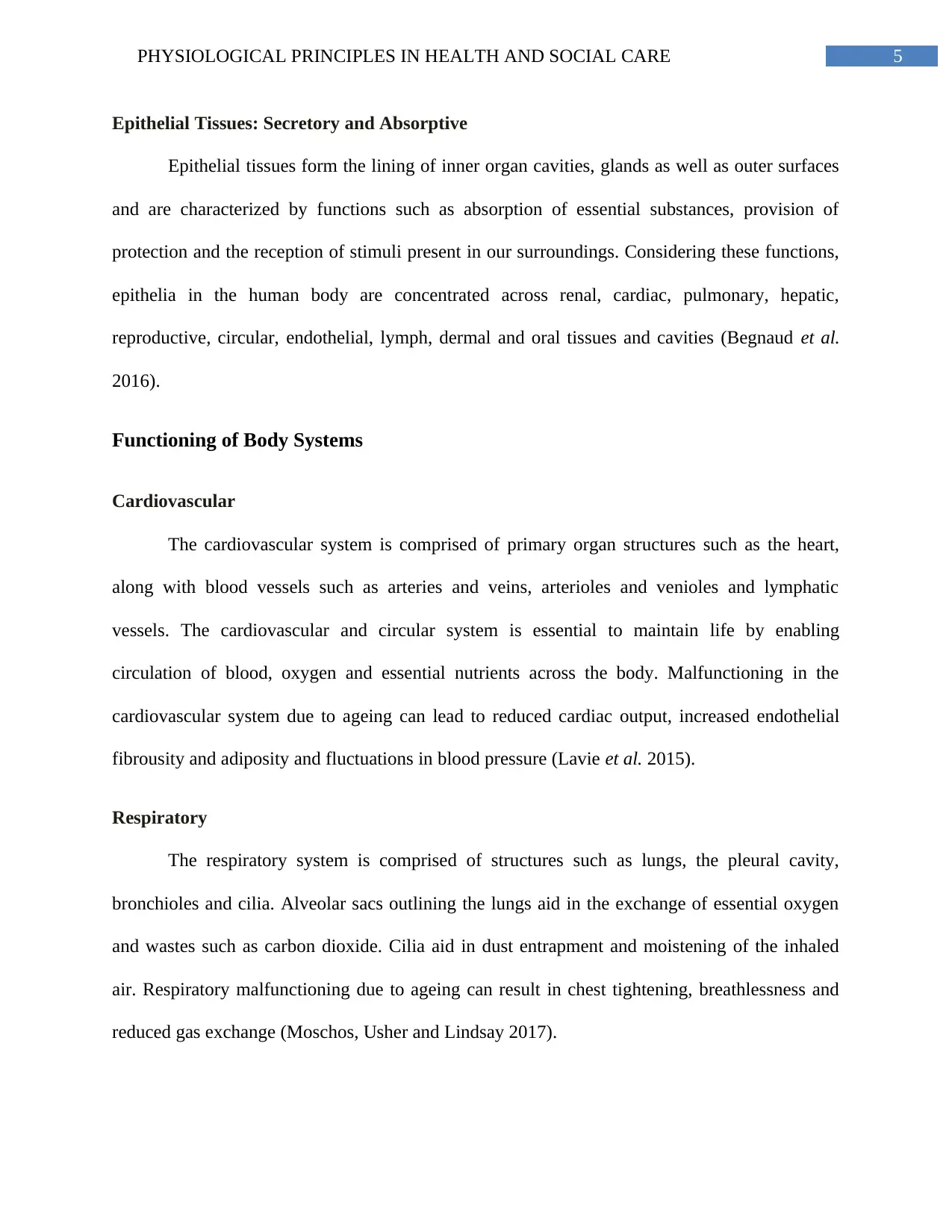
5PHYSIOLOGICAL PRINCIPLES IN HEALTH AND SOCIAL CARE
Epithelial Tissues: Secretory and Absorptive
Epithelial tissues form the lining of inner organ cavities, glands as well as outer surfaces
and are characterized by functions such as absorption of essential substances, provision of
protection and the reception of stimuli present in our surroundings. Considering these functions,
epithelia in the human body are concentrated across renal, cardiac, pulmonary, hepatic,
reproductive, circular, endothelial, lymph, dermal and oral tissues and cavities (Begnaud et al.
2016).
Functioning of Body Systems
Cardiovascular
The cardiovascular system is comprised of primary organ structures such as the heart,
along with blood vessels such as arteries and veins, arterioles and venioles and lymphatic
vessels. The cardiovascular and circular system is essential to maintain life by enabling
circulation of blood, oxygen and essential nutrients across the body. Malfunctioning in the
cardiovascular system due to ageing can lead to reduced cardiac output, increased endothelial
fibrousity and adiposity and fluctuations in blood pressure (Lavie et al. 2015).
Respiratory
The respiratory system is comprised of structures such as lungs, the pleural cavity,
bronchioles and cilia. Alveolar sacs outlining the lungs aid in the exchange of essential oxygen
and wastes such as carbon dioxide. Cilia aid in dust entrapment and moistening of the inhaled
air. Respiratory malfunctioning due to ageing can result in chest tightening, breathlessness and
reduced gas exchange (Moschos, Usher and Lindsay 2017).
Epithelial Tissues: Secretory and Absorptive
Epithelial tissues form the lining of inner organ cavities, glands as well as outer surfaces
and are characterized by functions such as absorption of essential substances, provision of
protection and the reception of stimuli present in our surroundings. Considering these functions,
epithelia in the human body are concentrated across renal, cardiac, pulmonary, hepatic,
reproductive, circular, endothelial, lymph, dermal and oral tissues and cavities (Begnaud et al.
2016).
Functioning of Body Systems
Cardiovascular
The cardiovascular system is comprised of primary organ structures such as the heart,
along with blood vessels such as arteries and veins, arterioles and venioles and lymphatic
vessels. The cardiovascular and circular system is essential to maintain life by enabling
circulation of blood, oxygen and essential nutrients across the body. Malfunctioning in the
cardiovascular system due to ageing can lead to reduced cardiac output, increased endothelial
fibrousity and adiposity and fluctuations in blood pressure (Lavie et al. 2015).
Respiratory
The respiratory system is comprised of structures such as lungs, the pleural cavity,
bronchioles and cilia. Alveolar sacs outlining the lungs aid in the exchange of essential oxygen
and wastes such as carbon dioxide. Cilia aid in dust entrapment and moistening of the inhaled
air. Respiratory malfunctioning due to ageing can result in chest tightening, breathlessness and
reduced gas exchange (Moschos, Usher and Lindsay 2017).
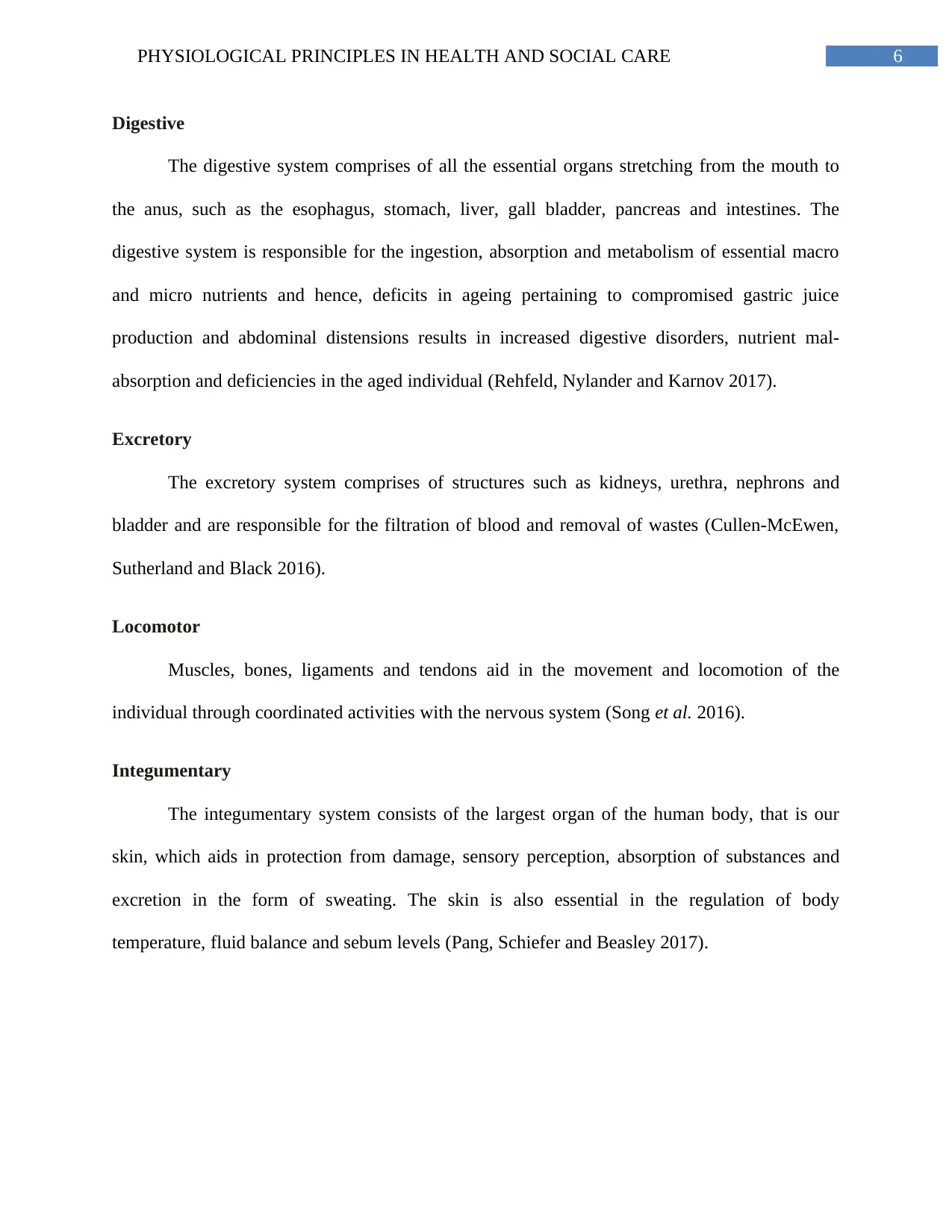
6PHYSIOLOGICAL PRINCIPLES IN HEALTH AND SOCIAL CARE
Digestive
The digestive system comprises of all the essential organs stretching from the mouth to
the anus, such as the esophagus, stomach, liver, gall bladder, pancreas and intestines. The
digestive system is responsible for the ingestion, absorption and metabolism of essential macro
and micro nutrients and hence, deficits in ageing pertaining to compromised gastric juice
production and abdominal distensions results in increased digestive disorders, nutrient mal-
absorption and deficiencies in the aged individual (Rehfeld, Nylander and Karnov 2017).
Excretory
The excretory system comprises of structures such as kidneys, urethra, nephrons and
bladder and are responsible for the filtration of blood and removal of wastes (Cullen-McEwen,
Sutherland and Black 2016).
Locomotor
Muscles, bones, ligaments and tendons aid in the movement and locomotion of the
individual through coordinated activities with the nervous system (Song et al. 2016).
Integumentary
The integumentary system consists of the largest organ of the human body, that is our
skin, which aids in protection from damage, sensory perception, absorption of substances and
excretion in the form of sweating. The skin is also essential in the regulation of body
temperature, fluid balance and sebum levels (Pang, Schiefer and Beasley 2017).
Digestive
The digestive system comprises of all the essential organs stretching from the mouth to
the anus, such as the esophagus, stomach, liver, gall bladder, pancreas and intestines. The
digestive system is responsible for the ingestion, absorption and metabolism of essential macro
and micro nutrients and hence, deficits in ageing pertaining to compromised gastric juice
production and abdominal distensions results in increased digestive disorders, nutrient mal-
absorption and deficiencies in the aged individual (Rehfeld, Nylander and Karnov 2017).
Excretory
The excretory system comprises of structures such as kidneys, urethra, nephrons and
bladder and are responsible for the filtration of blood and removal of wastes (Cullen-McEwen,
Sutherland and Black 2016).
Locomotor
Muscles, bones, ligaments and tendons aid in the movement and locomotion of the
individual through coordinated activities with the nervous system (Song et al. 2016).
Integumentary
The integumentary system consists of the largest organ of the human body, that is our
skin, which aids in protection from damage, sensory perception, absorption of substances and
excretion in the form of sweating. The skin is also essential in the regulation of body
temperature, fluid balance and sebum levels (Pang, Schiefer and Beasley 2017).
Paraphrase This Document
Need a fresh take? Get an instant paraphrase of this document with our AI Paraphraser
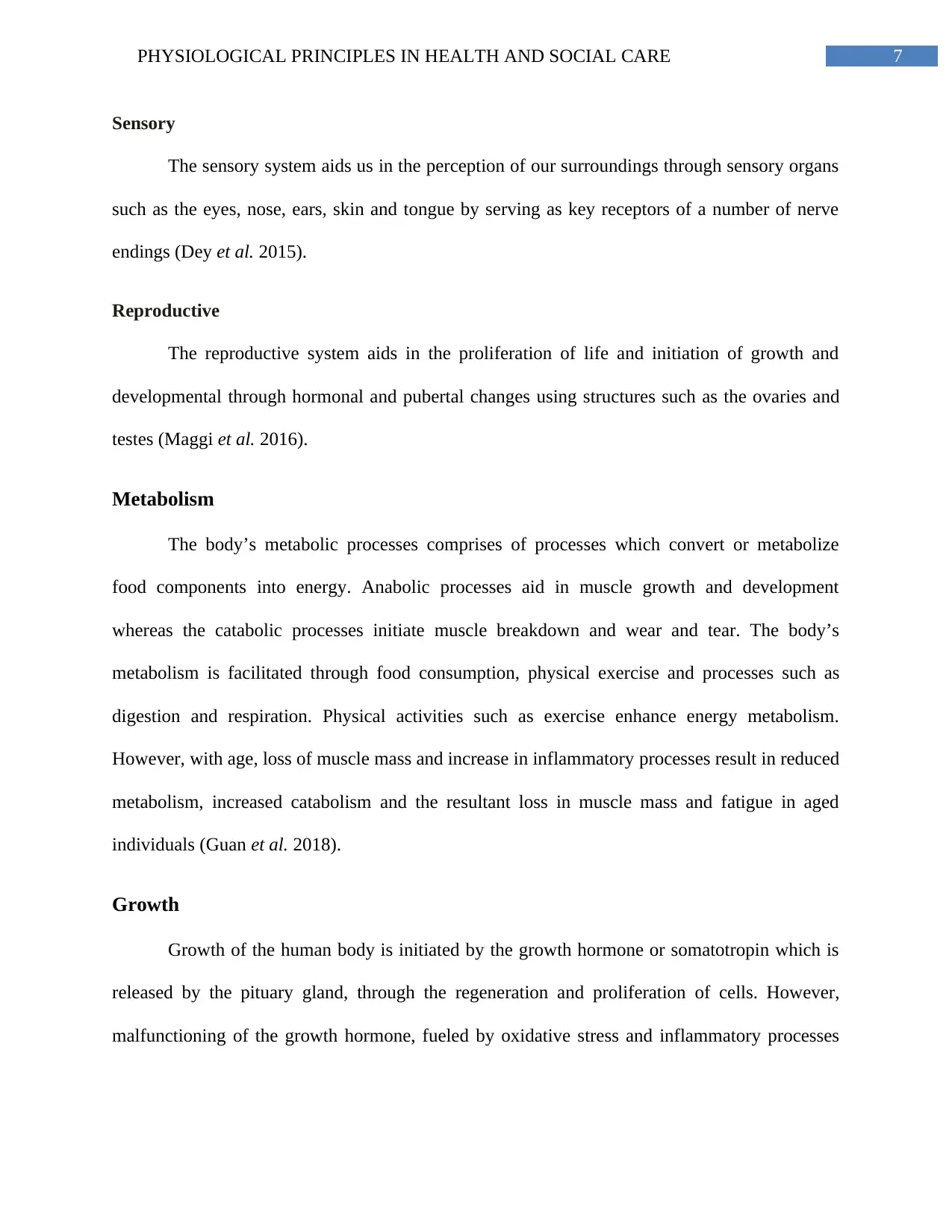
7PHYSIOLOGICAL PRINCIPLES IN HEALTH AND SOCIAL CARE
Sensory
The sensory system aids us in the perception of our surroundings through sensory organs
such as the eyes, nose, ears, skin and tongue by serving as key receptors of a number of nerve
endings (Dey et al. 2015).
Reproductive
The reproductive system aids in the proliferation of life and initiation of growth and
developmental through hormonal and pubertal changes using structures such as the ovaries and
testes (Maggi et al. 2016).
Metabolism
The body’s metabolic processes comprises of processes which convert or metabolize
food components into energy. Anabolic processes aid in muscle growth and development
whereas the catabolic processes initiate muscle breakdown and wear and tear. The body’s
metabolism is facilitated through food consumption, physical exercise and processes such as
digestion and respiration. Physical activities such as exercise enhance energy metabolism.
However, with age, loss of muscle mass and increase in inflammatory processes result in reduced
metabolism, increased catabolism and the resultant loss in muscle mass and fatigue in aged
individuals (Guan et al. 2018).
Growth
Growth of the human body is initiated by the growth hormone or somatotropin which is
released by the pituary gland, through the regeneration and proliferation of cells. However,
malfunctioning of the growth hormone, fueled by oxidative stress and inflammatory processes
Sensory
The sensory system aids us in the perception of our surroundings through sensory organs
such as the eyes, nose, ears, skin and tongue by serving as key receptors of a number of nerve
endings (Dey et al. 2015).
Reproductive
The reproductive system aids in the proliferation of life and initiation of growth and
developmental through hormonal and pubertal changes using structures such as the ovaries and
testes (Maggi et al. 2016).
Metabolism
The body’s metabolic processes comprises of processes which convert or metabolize
food components into energy. Anabolic processes aid in muscle growth and development
whereas the catabolic processes initiate muscle breakdown and wear and tear. The body’s
metabolism is facilitated through food consumption, physical exercise and processes such as
digestion and respiration. Physical activities such as exercise enhance energy metabolism.
However, with age, loss of muscle mass and increase in inflammatory processes result in reduced
metabolism, increased catabolism and the resultant loss in muscle mass and fatigue in aged
individuals (Guan et al. 2018).
Growth
Growth of the human body is initiated by the growth hormone or somatotropin which is
released by the pituary gland, through the regeneration and proliferation of cells. However,
malfunctioning of the growth hormone, fueled by oxidative stress and inflammatory processes
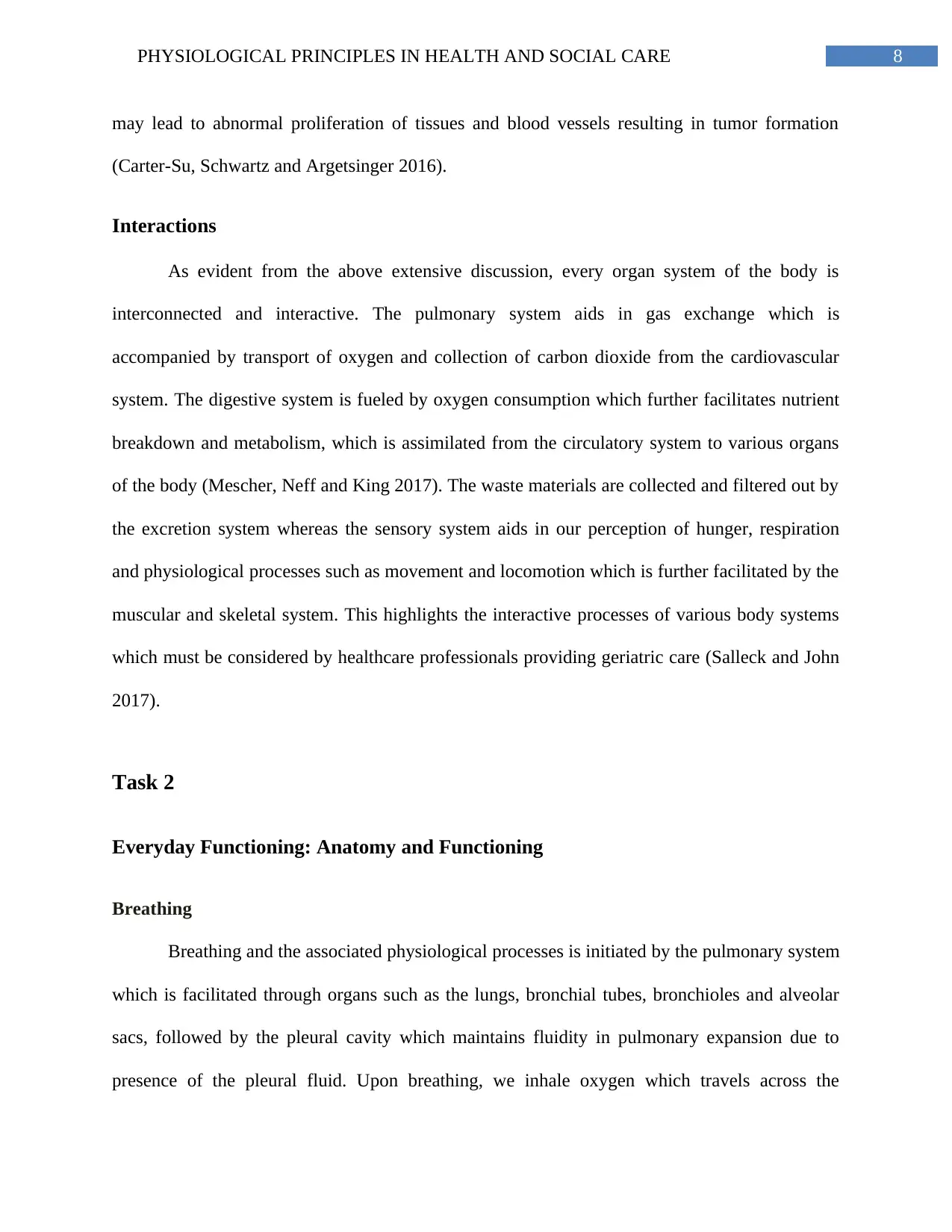
8PHYSIOLOGICAL PRINCIPLES IN HEALTH AND SOCIAL CARE
may lead to abnormal proliferation of tissues and blood vessels resulting in tumor formation
(Carter-Su, Schwartz and Argetsinger 2016).
Interactions
As evident from the above extensive discussion, every organ system of the body is
interconnected and interactive. The pulmonary system aids in gas exchange which is
accompanied by transport of oxygen and collection of carbon dioxide from the cardiovascular
system. The digestive system is fueled by oxygen consumption which further facilitates nutrient
breakdown and metabolism, which is assimilated from the circulatory system to various organs
of the body (Mescher, Neff and King 2017). The waste materials are collected and filtered out by
the excretion system whereas the sensory system aids in our perception of hunger, respiration
and physiological processes such as movement and locomotion which is further facilitated by the
muscular and skeletal system. This highlights the interactive processes of various body systems
which must be considered by healthcare professionals providing geriatric care (Salleck and John
2017).
Task 2
Everyday Functioning: Anatomy and Functioning
Breathing
Breathing and the associated physiological processes is initiated by the pulmonary system
which is facilitated through organs such as the lungs, bronchial tubes, bronchioles and alveolar
sacs, followed by the pleural cavity which maintains fluidity in pulmonary expansion due to
presence of the pleural fluid. Upon breathing, we inhale oxygen which travels across the
may lead to abnormal proliferation of tissues and blood vessels resulting in tumor formation
(Carter-Su, Schwartz and Argetsinger 2016).
Interactions
As evident from the above extensive discussion, every organ system of the body is
interconnected and interactive. The pulmonary system aids in gas exchange which is
accompanied by transport of oxygen and collection of carbon dioxide from the cardiovascular
system. The digestive system is fueled by oxygen consumption which further facilitates nutrient
breakdown and metabolism, which is assimilated from the circulatory system to various organs
of the body (Mescher, Neff and King 2017). The waste materials are collected and filtered out by
the excretion system whereas the sensory system aids in our perception of hunger, respiration
and physiological processes such as movement and locomotion which is further facilitated by the
muscular and skeletal system. This highlights the interactive processes of various body systems
which must be considered by healthcare professionals providing geriatric care (Salleck and John
2017).
Task 2
Everyday Functioning: Anatomy and Functioning
Breathing
Breathing and the associated physiological processes is initiated by the pulmonary system
which is facilitated through organs such as the lungs, bronchial tubes, bronchioles and alveolar
sacs, followed by the pleural cavity which maintains fluidity in pulmonary expansion due to
presence of the pleural fluid. Upon breathing, we inhale oxygen which travels across the
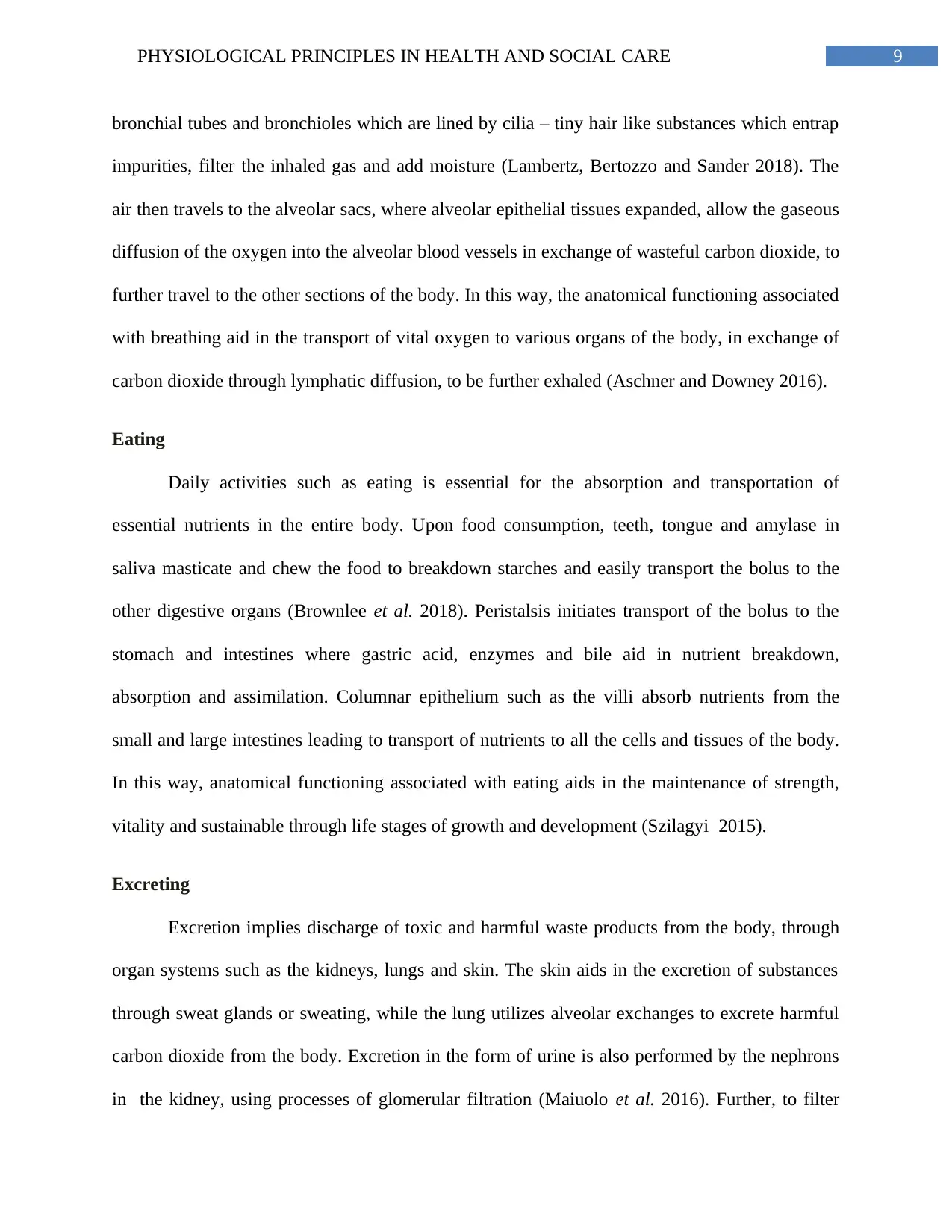
9PHYSIOLOGICAL PRINCIPLES IN HEALTH AND SOCIAL CARE
bronchial tubes and bronchioles which are lined by cilia – tiny hair like substances which entrap
impurities, filter the inhaled gas and add moisture (Lambertz, Bertozzo and Sander 2018). The
air then travels to the alveolar sacs, where alveolar epithelial tissues expanded, allow the gaseous
diffusion of the oxygen into the alveolar blood vessels in exchange of wasteful carbon dioxide, to
further travel to the other sections of the body. In this way, the anatomical functioning associated
with breathing aid in the transport of vital oxygen to various organs of the body, in exchange of
carbon dioxide through lymphatic diffusion, to be further exhaled (Aschner and Downey 2016).
Eating
Daily activities such as eating is essential for the absorption and transportation of
essential nutrients in the entire body. Upon food consumption, teeth, tongue and amylase in
saliva masticate and chew the food to breakdown starches and easily transport the bolus to the
other digestive organs (Brownlee et al. 2018). Peristalsis initiates transport of the bolus to the
stomach and intestines where gastric acid, enzymes and bile aid in nutrient breakdown,
absorption and assimilation. Columnar epithelium such as the villi absorb nutrients from the
small and large intestines leading to transport of nutrients to all the cells and tissues of the body.
In this way, anatomical functioning associated with eating aids in the maintenance of strength,
vitality and sustainable through life stages of growth and development (Szilagyi 2015).
Excreting
Excretion implies discharge of toxic and harmful waste products from the body, through
organ systems such as the kidneys, lungs and skin. The skin aids in the excretion of substances
through sweat glands or sweating, while the lung utilizes alveolar exchanges to excrete harmful
carbon dioxide from the body. Excretion in the form of urine is also performed by the nephrons
in the kidney, using processes of glomerular filtration (Maiuolo et al. 2016). Further, to filter
bronchial tubes and bronchioles which are lined by cilia – tiny hair like substances which entrap
impurities, filter the inhaled gas and add moisture (Lambertz, Bertozzo and Sander 2018). The
air then travels to the alveolar sacs, where alveolar epithelial tissues expanded, allow the gaseous
diffusion of the oxygen into the alveolar blood vessels in exchange of wasteful carbon dioxide, to
further travel to the other sections of the body. In this way, the anatomical functioning associated
with breathing aid in the transport of vital oxygen to various organs of the body, in exchange of
carbon dioxide through lymphatic diffusion, to be further exhaled (Aschner and Downey 2016).
Eating
Daily activities such as eating is essential for the absorption and transportation of
essential nutrients in the entire body. Upon food consumption, teeth, tongue and amylase in
saliva masticate and chew the food to breakdown starches and easily transport the bolus to the
other digestive organs (Brownlee et al. 2018). Peristalsis initiates transport of the bolus to the
stomach and intestines where gastric acid, enzymes and bile aid in nutrient breakdown,
absorption and assimilation. Columnar epithelium such as the villi absorb nutrients from the
small and large intestines leading to transport of nutrients to all the cells and tissues of the body.
In this way, anatomical functioning associated with eating aids in the maintenance of strength,
vitality and sustainable through life stages of growth and development (Szilagyi 2015).
Excreting
Excretion implies discharge of toxic and harmful waste products from the body, through
organ systems such as the kidneys, lungs and skin. The skin aids in the excretion of substances
through sweat glands or sweating, while the lung utilizes alveolar exchanges to excrete harmful
carbon dioxide from the body. Excretion in the form of urine is also performed by the nephrons
in the kidney, using processes of glomerular filtration (Maiuolo et al. 2016). Further, to filter
Secure Best Marks with AI Grader
Need help grading? Try our AI Grader for instant feedback on your assignments.
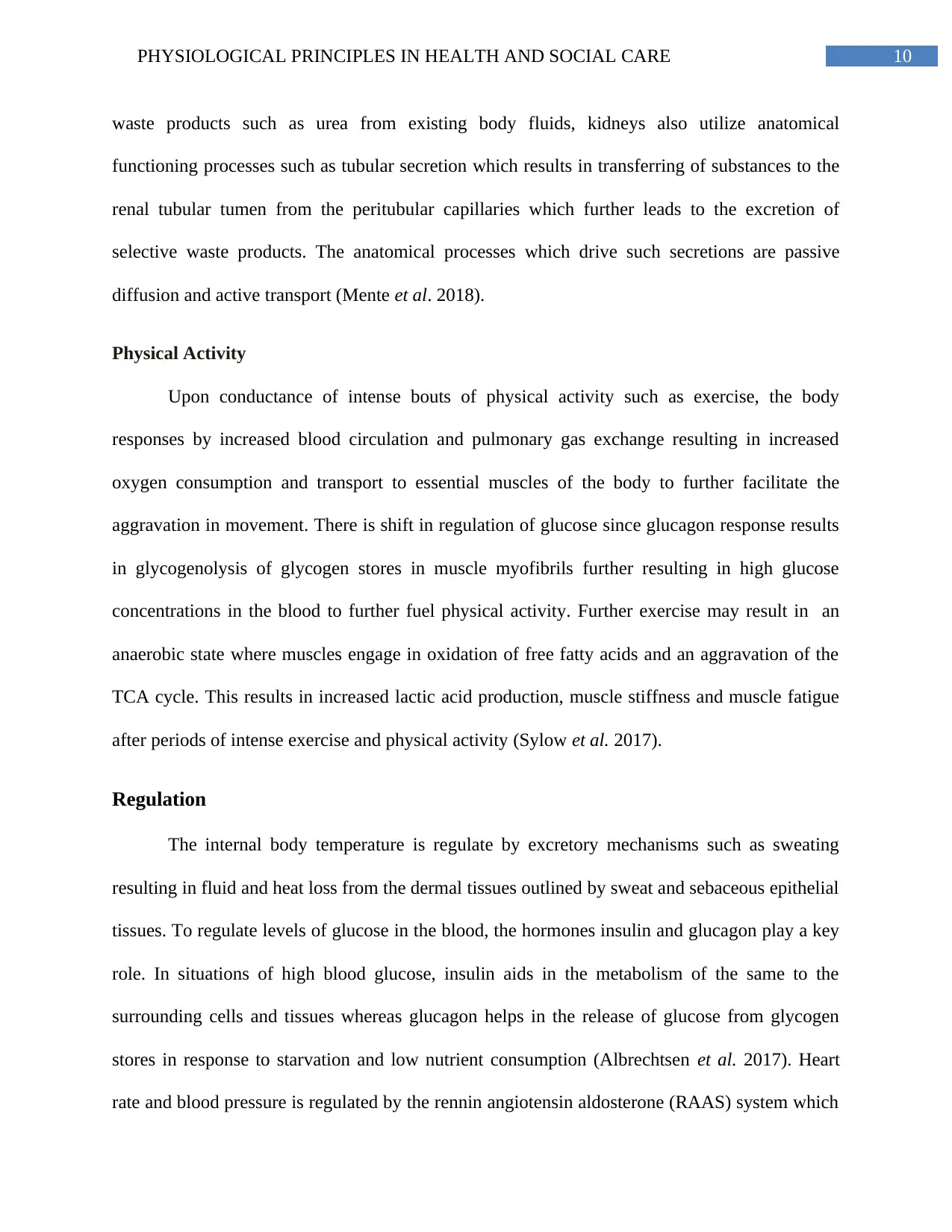
10PHYSIOLOGICAL PRINCIPLES IN HEALTH AND SOCIAL CARE
waste products such as urea from existing body fluids, kidneys also utilize anatomical
functioning processes such as tubular secretion which results in transferring of substances to the
renal tubular tumen from the peritubular capillaries which further leads to the excretion of
selective waste products. The anatomical processes which drive such secretions are passive
diffusion and active transport (Mente et al. 2018).
Physical Activity
Upon conductance of intense bouts of physical activity such as exercise, the body
responses by increased blood circulation and pulmonary gas exchange resulting in increased
oxygen consumption and transport to essential muscles of the body to further facilitate the
aggravation in movement. There is shift in regulation of glucose since glucagon response results
in glycogenolysis of glycogen stores in muscle myofibrils further resulting in high glucose
concentrations in the blood to further fuel physical activity. Further exercise may result in an
anaerobic state where muscles engage in oxidation of free fatty acids and an aggravation of the
TCA cycle. This results in increased lactic acid production, muscle stiffness and muscle fatigue
after periods of intense exercise and physical activity (Sylow et al. 2017).
Regulation
The internal body temperature is regulate by excretory mechanisms such as sweating
resulting in fluid and heat loss from the dermal tissues outlined by sweat and sebaceous epithelial
tissues. To regulate levels of glucose in the blood, the hormones insulin and glucagon play a key
role. In situations of high blood glucose, insulin aids in the metabolism of the same to the
surrounding cells and tissues whereas glucagon helps in the release of glucose from glycogen
stores in response to starvation and low nutrient consumption (Albrechtsen et al. 2017). Heart
rate and blood pressure is regulated by the rennin angiotensin aldosterone (RAAS) system which
waste products such as urea from existing body fluids, kidneys also utilize anatomical
functioning processes such as tubular secretion which results in transferring of substances to the
renal tubular tumen from the peritubular capillaries which further leads to the excretion of
selective waste products. The anatomical processes which drive such secretions are passive
diffusion and active transport (Mente et al. 2018).
Physical Activity
Upon conductance of intense bouts of physical activity such as exercise, the body
responses by increased blood circulation and pulmonary gas exchange resulting in increased
oxygen consumption and transport to essential muscles of the body to further facilitate the
aggravation in movement. There is shift in regulation of glucose since glucagon response results
in glycogenolysis of glycogen stores in muscle myofibrils further resulting in high glucose
concentrations in the blood to further fuel physical activity. Further exercise may result in an
anaerobic state where muscles engage in oxidation of free fatty acids and an aggravation of the
TCA cycle. This results in increased lactic acid production, muscle stiffness and muscle fatigue
after periods of intense exercise and physical activity (Sylow et al. 2017).
Regulation
The internal body temperature is regulate by excretory mechanisms such as sweating
resulting in fluid and heat loss from the dermal tissues outlined by sweat and sebaceous epithelial
tissues. To regulate levels of glucose in the blood, the hormones insulin and glucagon play a key
role. In situations of high blood glucose, insulin aids in the metabolism of the same to the
surrounding cells and tissues whereas glucagon helps in the release of glucose from glycogen
stores in response to starvation and low nutrient consumption (Albrechtsen et al. 2017). Heart
rate and blood pressure is regulated by the rennin angiotensin aldosterone (RAAS) system which
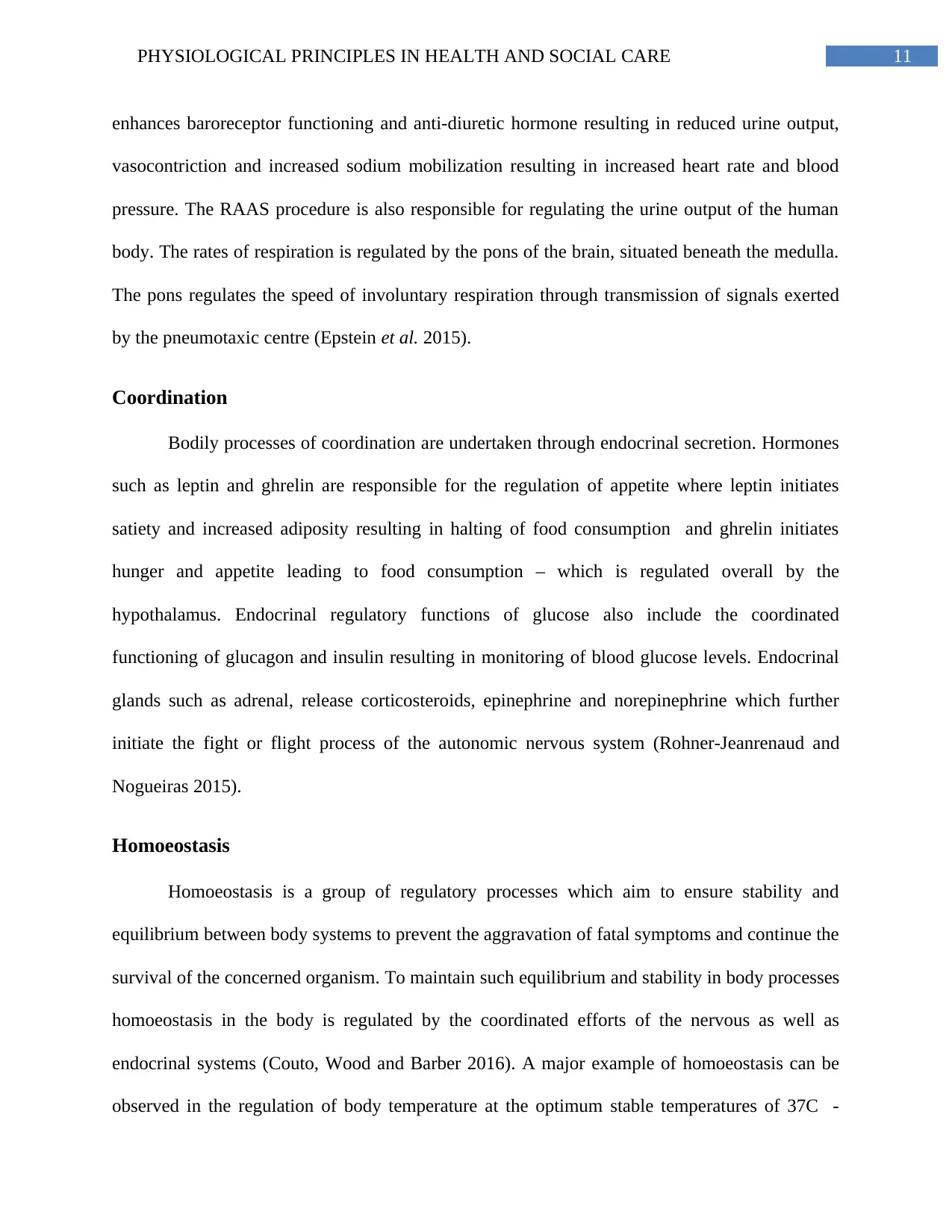
11PHYSIOLOGICAL PRINCIPLES IN HEALTH AND SOCIAL CARE
enhances baroreceptor functioning and anti-diuretic hormone resulting in reduced urine output,
vasocontriction and increased sodium mobilization resulting in increased heart rate and blood
pressure. The RAAS procedure is also responsible for regulating the urine output of the human
body. The rates of respiration is regulated by the pons of the brain, situated beneath the medulla.
The pons regulates the speed of involuntary respiration through transmission of signals exerted
by the pneumotaxic centre (Epstein et al. 2015).
Coordination
Bodily processes of coordination are undertaken through endocrinal secretion. Hormones
such as leptin and ghrelin are responsible for the regulation of appetite where leptin initiates
satiety and increased adiposity resulting in halting of food consumption and ghrelin initiates
hunger and appetite leading to food consumption – which is regulated overall by the
hypothalamus. Endocrinal regulatory functions of glucose also include the coordinated
functioning of glucagon and insulin resulting in monitoring of blood glucose levels. Endocrinal
glands such as adrenal, release corticosteroids, epinephrine and norepinephrine which further
initiate the fight or flight process of the autonomic nervous system (Rohner-Jeanrenaud and
Nogueiras 2015).
Homoeostasis
Homoeostasis is a group of regulatory processes which aim to ensure stability and
equilibrium between body systems to prevent the aggravation of fatal symptoms and continue the
survival of the concerned organism. To maintain such equilibrium and stability in body processes
homoeostasis in the body is regulated by the coordinated efforts of the nervous as well as
endocrinal systems (Couto, Wood and Barber 2016). A major example of homoeostasis can be
observed in the regulation of body temperature at the optimum stable temperatures of 37C -
enhances baroreceptor functioning and anti-diuretic hormone resulting in reduced urine output,
vasocontriction and increased sodium mobilization resulting in increased heart rate and blood
pressure. The RAAS procedure is also responsible for regulating the urine output of the human
body. The rates of respiration is regulated by the pons of the brain, situated beneath the medulla.
The pons regulates the speed of involuntary respiration through transmission of signals exerted
by the pneumotaxic centre (Epstein et al. 2015).
Coordination
Bodily processes of coordination are undertaken through endocrinal secretion. Hormones
such as leptin and ghrelin are responsible for the regulation of appetite where leptin initiates
satiety and increased adiposity resulting in halting of food consumption and ghrelin initiates
hunger and appetite leading to food consumption – which is regulated overall by the
hypothalamus. Endocrinal regulatory functions of glucose also include the coordinated
functioning of glucagon and insulin resulting in monitoring of blood glucose levels. Endocrinal
glands such as adrenal, release corticosteroids, epinephrine and norepinephrine which further
initiate the fight or flight process of the autonomic nervous system (Rohner-Jeanrenaud and
Nogueiras 2015).
Homoeostasis
Homoeostasis is a group of regulatory processes which aim to ensure stability and
equilibrium between body systems to prevent the aggravation of fatal symptoms and continue the
survival of the concerned organism. To maintain such equilibrium and stability in body processes
homoeostasis in the body is regulated by the coordinated efforts of the nervous as well as
endocrinal systems (Couto, Wood and Barber 2016). A major example of homoeostasis can be
observed in the regulation of body temperature at the optimum stable temperatures of 37C -

12PHYSIOLOGICAL PRINCIPLES IN HEALTH AND SOCIAL CARE
which is performed by the hypothalamus by exerting changes in the rates of breathing, glucose
oxidation and rates of metabolism (Tesch et al. 2018). Further, homoeostatic processes to
regulate levels of gas exchange at optimal levels are undertaken at the pons, by stimulating
peripheral chemoreceptors which monitor the partial pressure of carbon dioxide and oxygen.
Similarly, glucose homoeostasis and blood pressure homoeostasis is undertaken by endrocrinal
processes such as pancreatic insulin-glucagon regulation and RAAS physiological processes
upon detection of elevation or reduction of blood glucose and blood pressure rates. Similarly,
serum calcium and bone calcium homoeostasis is maintained by the parathyroid hormones
calcitonin which regulate osteoclastic and osteoblastic activity as a response to calcium
disturbances in the form of bone injuries and drops in serum calcium levels (van der Beld et al.
2018).
Importance in Supporting Service User Needs
It is to noted that ageing is associated with detrimental effects in metabolic, regulatory,
hormonal and endocrinal functioning which result in loss of homoeostasis, loss of equilibrium,
increased inflammatory process, accumulation of waste products and aggravation of metabolic
symptoms. Hence, the above information is vital for elderly service users since health
professionals and workers can use these to carry comprehensive assessments and diagnosis and
provide holistic treatment encompassing the interrelated symptoms exerted as a result of even a
single loss of functioning in any of the essential body systems (Bauer, Fetherstonhaugh and
Winbolt 2018). Obtaining evidence based research on the various interconnected principles
outlining physiological processes will help health workers to target assessments based on varied
symptomatic complaints and address the same through the provision of a multidisciplinary
approach to treatment and healthcare (Stapley et al. 2017).
which is performed by the hypothalamus by exerting changes in the rates of breathing, glucose
oxidation and rates of metabolism (Tesch et al. 2018). Further, homoeostatic processes to
regulate levels of gas exchange at optimal levels are undertaken at the pons, by stimulating
peripheral chemoreceptors which monitor the partial pressure of carbon dioxide and oxygen.
Similarly, glucose homoeostasis and blood pressure homoeostasis is undertaken by endrocrinal
processes such as pancreatic insulin-glucagon regulation and RAAS physiological processes
upon detection of elevation or reduction of blood glucose and blood pressure rates. Similarly,
serum calcium and bone calcium homoeostasis is maintained by the parathyroid hormones
calcitonin which regulate osteoclastic and osteoblastic activity as a response to calcium
disturbances in the form of bone injuries and drops in serum calcium levels (van der Beld et al.
2018).
Importance in Supporting Service User Needs
It is to noted that ageing is associated with detrimental effects in metabolic, regulatory,
hormonal and endocrinal functioning which result in loss of homoeostasis, loss of equilibrium,
increased inflammatory process, accumulation of waste products and aggravation of metabolic
symptoms. Hence, the above information is vital for elderly service users since health
professionals and workers can use these to carry comprehensive assessments and diagnosis and
provide holistic treatment encompassing the interrelated symptoms exerted as a result of even a
single loss of functioning in any of the essential body systems (Bauer, Fetherstonhaugh and
Winbolt 2018). Obtaining evidence based research on the various interconnected principles
outlining physiological processes will help health workers to target assessments based on varied
symptomatic complaints and address the same through the provision of a multidisciplinary
approach to treatment and healthcare (Stapley et al. 2017).
Paraphrase This Document
Need a fresh take? Get an instant paraphrase of this document with our AI Paraphraser
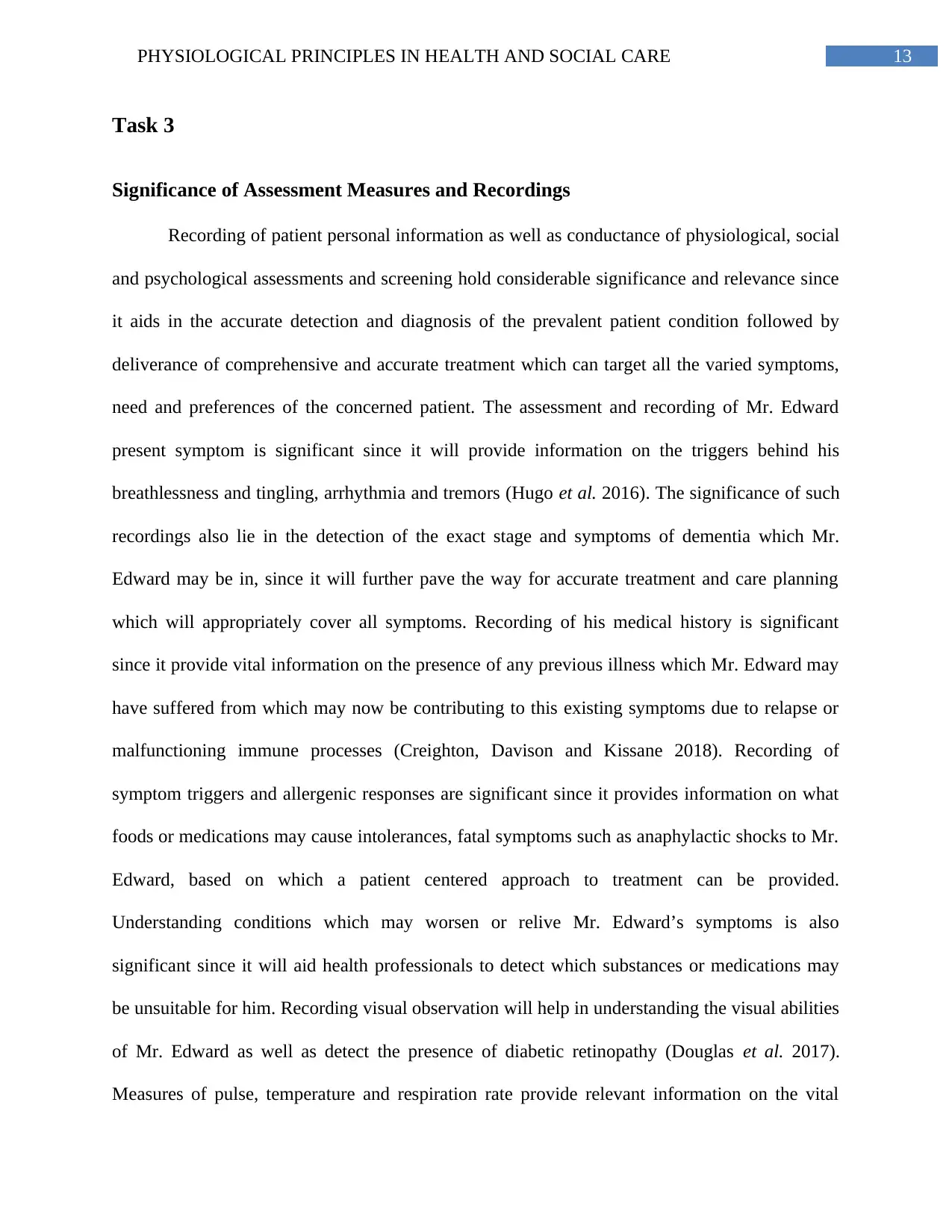
13PHYSIOLOGICAL PRINCIPLES IN HEALTH AND SOCIAL CARE
Task 3
Significance of Assessment Measures and Recordings
Recording of patient personal information as well as conductance of physiological, social
and psychological assessments and screening hold considerable significance and relevance since
it aids in the accurate detection and diagnosis of the prevalent patient condition followed by
deliverance of comprehensive and accurate treatment which can target all the varied symptoms,
need and preferences of the concerned patient. The assessment and recording of Mr. Edward
present symptom is significant since it will provide information on the triggers behind his
breathlessness and tingling, arrhythmia and tremors (Hugo et al. 2016). The significance of such
recordings also lie in the detection of the exact stage and symptoms of dementia which Mr.
Edward may be in, since it will further pave the way for accurate treatment and care planning
which will appropriately cover all symptoms. Recording of his medical history is significant
since it provide vital information on the presence of any previous illness which Mr. Edward may
have suffered from which may now be contributing to this existing symptoms due to relapse or
malfunctioning immune processes (Creighton, Davison and Kissane 2018). Recording of
symptom triggers and allergenic responses are significant since it provides information on what
foods or medications may cause intolerances, fatal symptoms such as anaphylactic shocks to Mr.
Edward, based on which a patient centered approach to treatment can be provided.
Understanding conditions which may worsen or relive Mr. Edward’s symptoms is also
significant since it will aid health professionals to detect which substances or medications may
be unsuitable for him. Recording visual observation will help in understanding the visual abilities
of Mr. Edward as well as detect the presence of diabetic retinopathy (Douglas et al. 2017).
Measures of pulse, temperature and respiration rate provide relevant information on the vital
Task 3
Significance of Assessment Measures and Recordings
Recording of patient personal information as well as conductance of physiological, social
and psychological assessments and screening hold considerable significance and relevance since
it aids in the accurate detection and diagnosis of the prevalent patient condition followed by
deliverance of comprehensive and accurate treatment which can target all the varied symptoms,
need and preferences of the concerned patient. The assessment and recording of Mr. Edward
present symptom is significant since it will provide information on the triggers behind his
breathlessness and tingling, arrhythmia and tremors (Hugo et al. 2016). The significance of such
recordings also lie in the detection of the exact stage and symptoms of dementia which Mr.
Edward may be in, since it will further pave the way for accurate treatment and care planning
which will appropriately cover all symptoms. Recording of his medical history is significant
since it provide vital information on the presence of any previous illness which Mr. Edward may
have suffered from which may now be contributing to this existing symptoms due to relapse or
malfunctioning immune processes (Creighton, Davison and Kissane 2018). Recording of
symptom triggers and allergenic responses are significant since it provides information on what
foods or medications may cause intolerances, fatal symptoms such as anaphylactic shocks to Mr.
Edward, based on which a patient centered approach to treatment can be provided.
Understanding conditions which may worsen or relive Mr. Edward’s symptoms is also
significant since it will aid health professionals to detect which substances or medications may
be unsuitable for him. Recording visual observation will help in understanding the visual abilities
of Mr. Edward as well as detect the presence of diabetic retinopathy (Douglas et al. 2017).
Measures of pulse, temperature and respiration rate provide relevant information on the vital
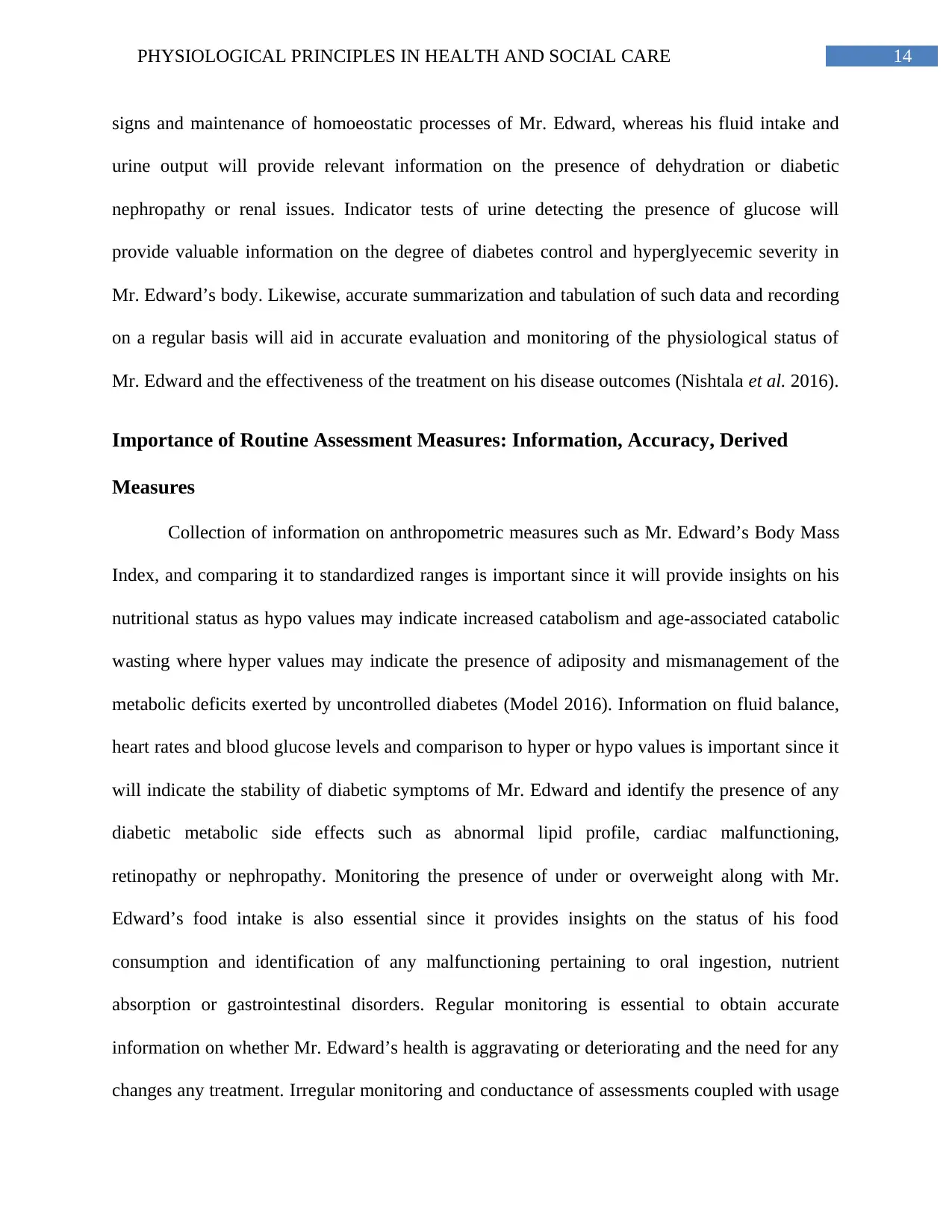
14PHYSIOLOGICAL PRINCIPLES IN HEALTH AND SOCIAL CARE
signs and maintenance of homoeostatic processes of Mr. Edward, whereas his fluid intake and
urine output will provide relevant information on the presence of dehydration or diabetic
nephropathy or renal issues. Indicator tests of urine detecting the presence of glucose will
provide valuable information on the degree of diabetes control and hyperglyecemic severity in
Mr. Edward’s body. Likewise, accurate summarization and tabulation of such data and recording
on a regular basis will aid in accurate evaluation and monitoring of the physiological status of
Mr. Edward and the effectiveness of the treatment on his disease outcomes (Nishtala et al. 2016).
Importance of Routine Assessment Measures: Information, Accuracy, Derived
Measures
Collection of information on anthropometric measures such as Mr. Edward’s Body Mass
Index, and comparing it to standardized ranges is important since it will provide insights on his
nutritional status as hypo values may indicate increased catabolism and age-associated catabolic
wasting where hyper values may indicate the presence of adiposity and mismanagement of the
metabolic deficits exerted by uncontrolled diabetes (Model 2016). Information on fluid balance,
heart rates and blood glucose levels and comparison to hyper or hypo values is important since it
will indicate the stability of diabetic symptoms of Mr. Edward and identify the presence of any
diabetic metabolic side effects such as abnormal lipid profile, cardiac malfunctioning,
retinopathy or nephropathy. Monitoring the presence of under or overweight along with Mr.
Edward’s food intake is also essential since it provides insights on the status of his food
consumption and identification of any malfunctioning pertaining to oral ingestion, nutrient
absorption or gastrointestinal disorders. Regular monitoring is essential to obtain accurate
information on whether Mr. Edward’s health is aggravating or deteriorating and the need for any
changes any treatment. Irregular monitoring and conductance of assessments coupled with usage
signs and maintenance of homoeostatic processes of Mr. Edward, whereas his fluid intake and
urine output will provide relevant information on the presence of dehydration or diabetic
nephropathy or renal issues. Indicator tests of urine detecting the presence of glucose will
provide valuable information on the degree of diabetes control and hyperglyecemic severity in
Mr. Edward’s body. Likewise, accurate summarization and tabulation of such data and recording
on a regular basis will aid in accurate evaluation and monitoring of the physiological status of
Mr. Edward and the effectiveness of the treatment on his disease outcomes (Nishtala et al. 2016).
Importance of Routine Assessment Measures: Information, Accuracy, Derived
Measures
Collection of information on anthropometric measures such as Mr. Edward’s Body Mass
Index, and comparing it to standardized ranges is important since it will provide insights on his
nutritional status as hypo values may indicate increased catabolism and age-associated catabolic
wasting where hyper values may indicate the presence of adiposity and mismanagement of the
metabolic deficits exerted by uncontrolled diabetes (Model 2016). Information on fluid balance,
heart rates and blood glucose levels and comparison to hyper or hypo values is important since it
will indicate the stability of diabetic symptoms of Mr. Edward and identify the presence of any
diabetic metabolic side effects such as abnormal lipid profile, cardiac malfunctioning,
retinopathy or nephropathy. Monitoring the presence of under or overweight along with Mr.
Edward’s food intake is also essential since it provides insights on the status of his food
consumption and identification of any malfunctioning pertaining to oral ingestion, nutrient
absorption or gastrointestinal disorders. Regular monitoring is essential to obtain accurate
information on whether Mr. Edward’s health is aggravating or deteriorating and the need for any
changes any treatment. Irregular monitoring and conductance of assessments coupled with usage
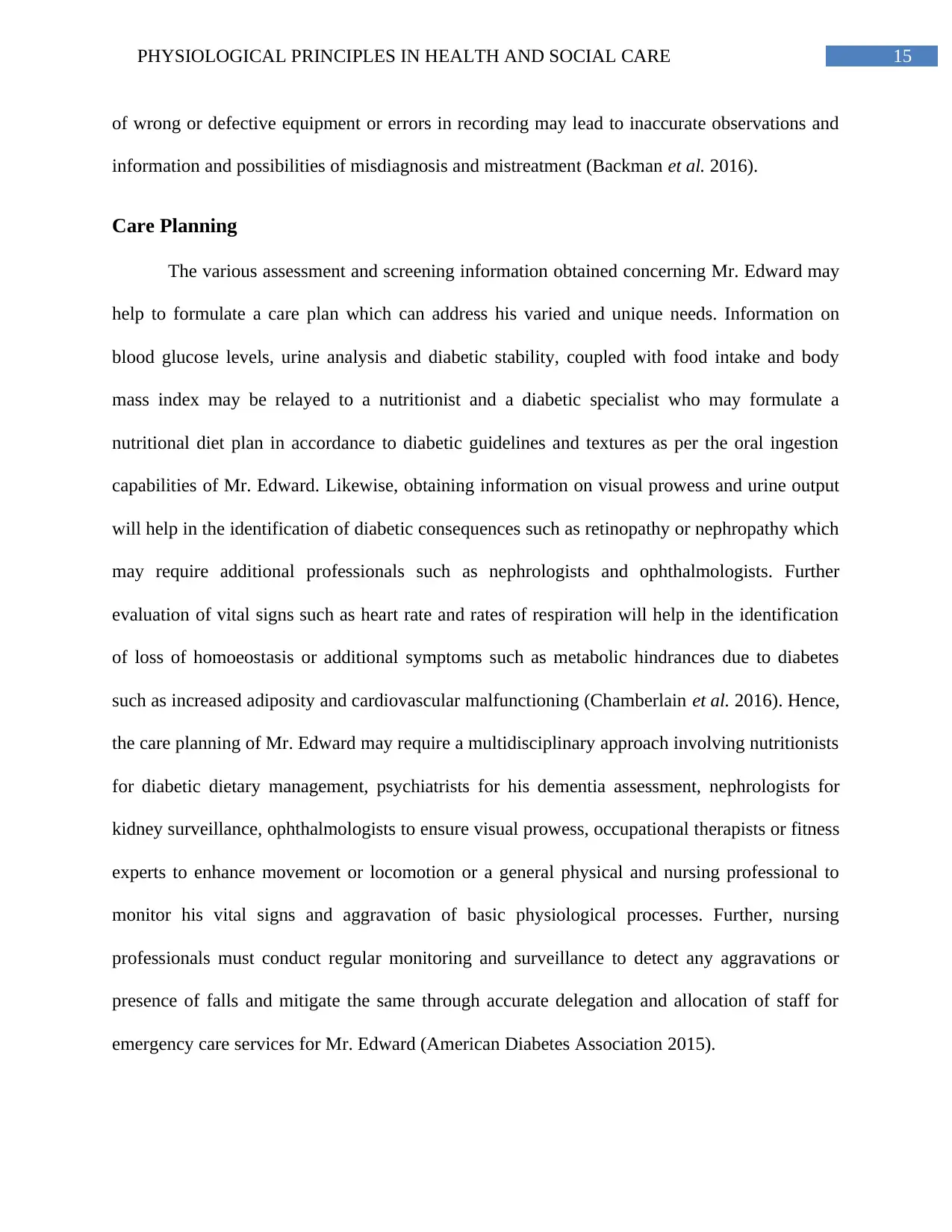
15PHYSIOLOGICAL PRINCIPLES IN HEALTH AND SOCIAL CARE
of wrong or defective equipment or errors in recording may lead to inaccurate observations and
information and possibilities of misdiagnosis and mistreatment (Backman et al. 2016).
Care Planning
The various assessment and screening information obtained concerning Mr. Edward may
help to formulate a care plan which can address his varied and unique needs. Information on
blood glucose levels, urine analysis and diabetic stability, coupled with food intake and body
mass index may be relayed to a nutritionist and a diabetic specialist who may formulate a
nutritional diet plan in accordance to diabetic guidelines and textures as per the oral ingestion
capabilities of Mr. Edward. Likewise, obtaining information on visual prowess and urine output
will help in the identification of diabetic consequences such as retinopathy or nephropathy which
may require additional professionals such as nephrologists and ophthalmologists. Further
evaluation of vital signs such as heart rate and rates of respiration will help in the identification
of loss of homoeostasis or additional symptoms such as metabolic hindrances due to diabetes
such as increased adiposity and cardiovascular malfunctioning (Chamberlain et al. 2016). Hence,
the care planning of Mr. Edward may require a multidisciplinary approach involving nutritionists
for diabetic dietary management, psychiatrists for his dementia assessment, nephrologists for
kidney surveillance, ophthalmologists to ensure visual prowess, occupational therapists or fitness
experts to enhance movement or locomotion or a general physical and nursing professional to
monitor his vital signs and aggravation of basic physiological processes. Further, nursing
professionals must conduct regular monitoring and surveillance to detect any aggravations or
presence of falls and mitigate the same through accurate delegation and allocation of staff for
emergency care services for Mr. Edward (American Diabetes Association 2015).
of wrong or defective equipment or errors in recording may lead to inaccurate observations and
information and possibilities of misdiagnosis and mistreatment (Backman et al. 2016).
Care Planning
The various assessment and screening information obtained concerning Mr. Edward may
help to formulate a care plan which can address his varied and unique needs. Information on
blood glucose levels, urine analysis and diabetic stability, coupled with food intake and body
mass index may be relayed to a nutritionist and a diabetic specialist who may formulate a
nutritional diet plan in accordance to diabetic guidelines and textures as per the oral ingestion
capabilities of Mr. Edward. Likewise, obtaining information on visual prowess and urine output
will help in the identification of diabetic consequences such as retinopathy or nephropathy which
may require additional professionals such as nephrologists and ophthalmologists. Further
evaluation of vital signs such as heart rate and rates of respiration will help in the identification
of loss of homoeostasis or additional symptoms such as metabolic hindrances due to diabetes
such as increased adiposity and cardiovascular malfunctioning (Chamberlain et al. 2016). Hence,
the care planning of Mr. Edward may require a multidisciplinary approach involving nutritionists
for diabetic dietary management, psychiatrists for his dementia assessment, nephrologists for
kidney surveillance, ophthalmologists to ensure visual prowess, occupational therapists or fitness
experts to enhance movement or locomotion or a general physical and nursing professional to
monitor his vital signs and aggravation of basic physiological processes. Further, nursing
professionals must conduct regular monitoring and surveillance to detect any aggravations or
presence of falls and mitigate the same through accurate delegation and allocation of staff for
emergency care services for Mr. Edward (American Diabetes Association 2015).
Secure Best Marks with AI Grader
Need help grading? Try our AI Grader for instant feedback on your assignments.
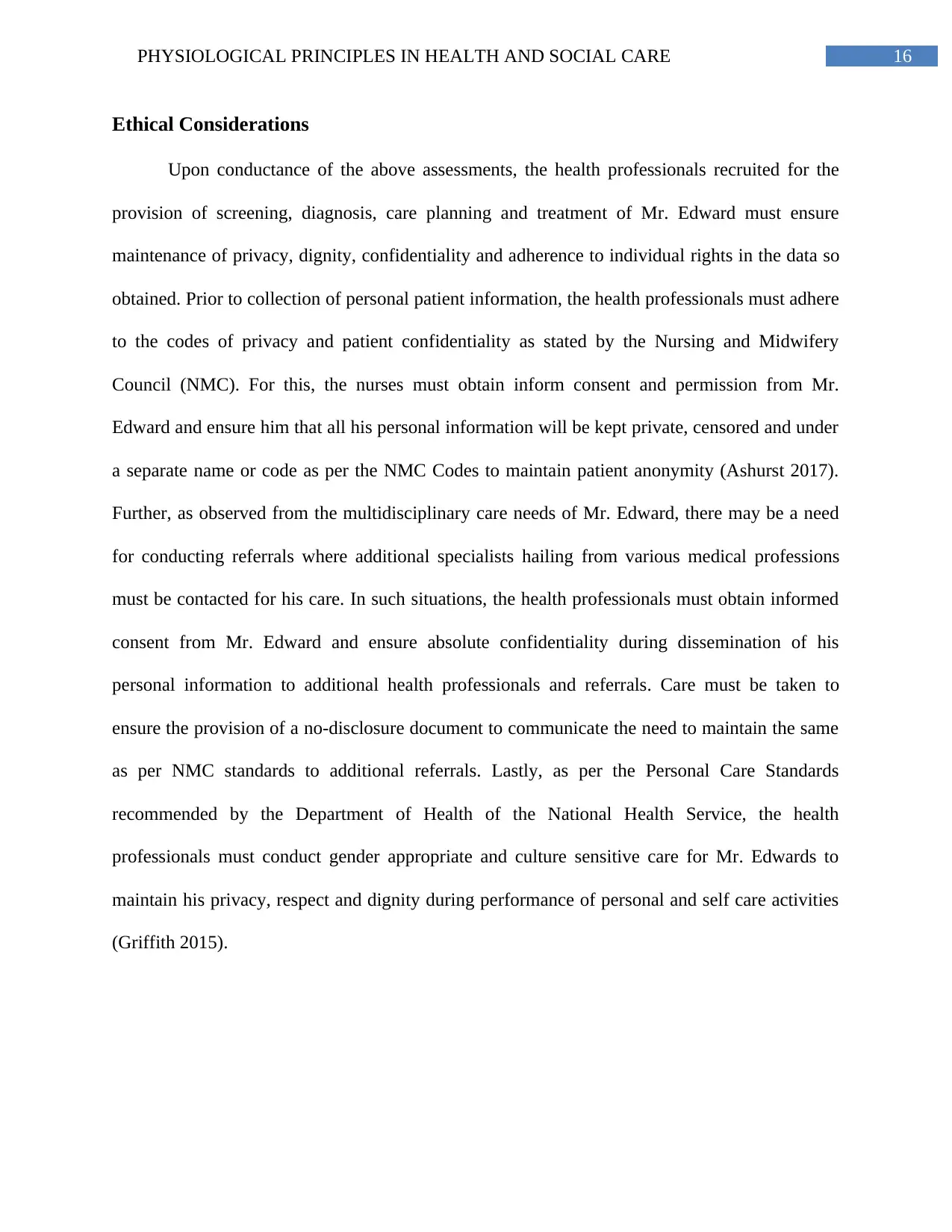
16PHYSIOLOGICAL PRINCIPLES IN HEALTH AND SOCIAL CARE
Ethical Considerations
Upon conductance of the above assessments, the health professionals recruited for the
provision of screening, diagnosis, care planning and treatment of Mr. Edward must ensure
maintenance of privacy, dignity, confidentiality and adherence to individual rights in the data so
obtained. Prior to collection of personal patient information, the health professionals must adhere
to the codes of privacy and patient confidentiality as stated by the Nursing and Midwifery
Council (NMC). For this, the nurses must obtain inform consent and permission from Mr.
Edward and ensure him that all his personal information will be kept private, censored and under
a separate name or code as per the NMC Codes to maintain patient anonymity (Ashurst 2017).
Further, as observed from the multidisciplinary care needs of Mr. Edward, there may be a need
for conducting referrals where additional specialists hailing from various medical professions
must be contacted for his care. In such situations, the health professionals must obtain informed
consent from Mr. Edward and ensure absolute confidentiality during dissemination of his
personal information to additional health professionals and referrals. Care must be taken to
ensure the provision of a no-disclosure document to communicate the need to maintain the same
as per NMC standards to additional referrals. Lastly, as per the Personal Care Standards
recommended by the Department of Health of the National Health Service, the health
professionals must conduct gender appropriate and culture sensitive care for Mr. Edwards to
maintain his privacy, respect and dignity during performance of personal and self care activities
(Griffith 2015).
Ethical Considerations
Upon conductance of the above assessments, the health professionals recruited for the
provision of screening, diagnosis, care planning and treatment of Mr. Edward must ensure
maintenance of privacy, dignity, confidentiality and adherence to individual rights in the data so
obtained. Prior to collection of personal patient information, the health professionals must adhere
to the codes of privacy and patient confidentiality as stated by the Nursing and Midwifery
Council (NMC). For this, the nurses must obtain inform consent and permission from Mr.
Edward and ensure him that all his personal information will be kept private, censored and under
a separate name or code as per the NMC Codes to maintain patient anonymity (Ashurst 2017).
Further, as observed from the multidisciplinary care needs of Mr. Edward, there may be a need
for conducting referrals where additional specialists hailing from various medical professions
must be contacted for his care. In such situations, the health professionals must obtain informed
consent from Mr. Edward and ensure absolute confidentiality during dissemination of his
personal information to additional health professionals and referrals. Care must be taken to
ensure the provision of a no-disclosure document to communicate the need to maintain the same
as per NMC standards to additional referrals. Lastly, as per the Personal Care Standards
recommended by the Department of Health of the National Health Service, the health
professionals must conduct gender appropriate and culture sensitive care for Mr. Edwards to
maintain his privacy, respect and dignity during performance of personal and self care activities
(Griffith 2015).
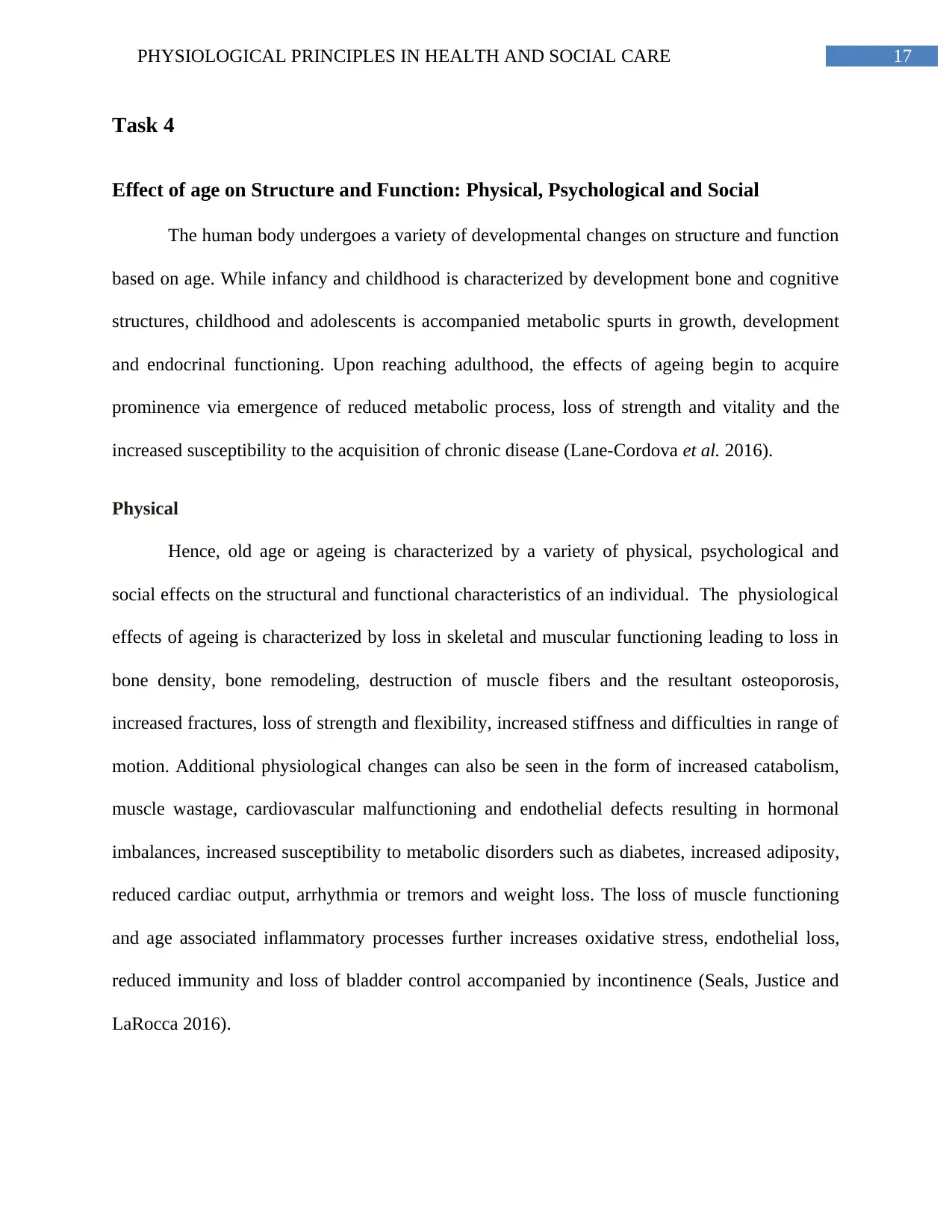
17PHYSIOLOGICAL PRINCIPLES IN HEALTH AND SOCIAL CARE
Task 4
Effect of age on Structure and Function: Physical, Psychological and Social
The human body undergoes a variety of developmental changes on structure and function
based on age. While infancy and childhood is characterized by development bone and cognitive
structures, childhood and adolescents is accompanied metabolic spurts in growth, development
and endocrinal functioning. Upon reaching adulthood, the effects of ageing begin to acquire
prominence via emergence of reduced metabolic process, loss of strength and vitality and the
increased susceptibility to the acquisition of chronic disease (Lane-Cordova et al. 2016).
Physical
Hence, old age or ageing is characterized by a variety of physical, psychological and
social effects on the structural and functional characteristics of an individual. The physiological
effects of ageing is characterized by loss in skeletal and muscular functioning leading to loss in
bone density, bone remodeling, destruction of muscle fibers and the resultant osteoporosis,
increased fractures, loss of strength and flexibility, increased stiffness and difficulties in range of
motion. Additional physiological changes can also be seen in the form of increased catabolism,
muscle wastage, cardiovascular malfunctioning and endothelial defects resulting in hormonal
imbalances, increased susceptibility to metabolic disorders such as diabetes, increased adiposity,
reduced cardiac output, arrhythmia or tremors and weight loss. The loss of muscle functioning
and age associated inflammatory processes further increases oxidative stress, endothelial loss,
reduced immunity and loss of bladder control accompanied by incontinence (Seals, Justice and
LaRocca 2016).
Task 4
Effect of age on Structure and Function: Physical, Psychological and Social
The human body undergoes a variety of developmental changes on structure and function
based on age. While infancy and childhood is characterized by development bone and cognitive
structures, childhood and adolescents is accompanied metabolic spurts in growth, development
and endocrinal functioning. Upon reaching adulthood, the effects of ageing begin to acquire
prominence via emergence of reduced metabolic process, loss of strength and vitality and the
increased susceptibility to the acquisition of chronic disease (Lane-Cordova et al. 2016).
Physical
Hence, old age or ageing is characterized by a variety of physical, psychological and
social effects on the structural and functional characteristics of an individual. The physiological
effects of ageing is characterized by loss in skeletal and muscular functioning leading to loss in
bone density, bone remodeling, destruction of muscle fibers and the resultant osteoporosis,
increased fractures, loss of strength and flexibility, increased stiffness and difficulties in range of
motion. Additional physiological changes can also be seen in the form of increased catabolism,
muscle wastage, cardiovascular malfunctioning and endothelial defects resulting in hormonal
imbalances, increased susceptibility to metabolic disorders such as diabetes, increased adiposity,
reduced cardiac output, arrhythmia or tremors and weight loss. The loss of muscle functioning
and age associated inflammatory processes further increases oxidative stress, endothelial loss,
reduced immunity and loss of bladder control accompanied by incontinence (Seals, Justice and
LaRocca 2016).
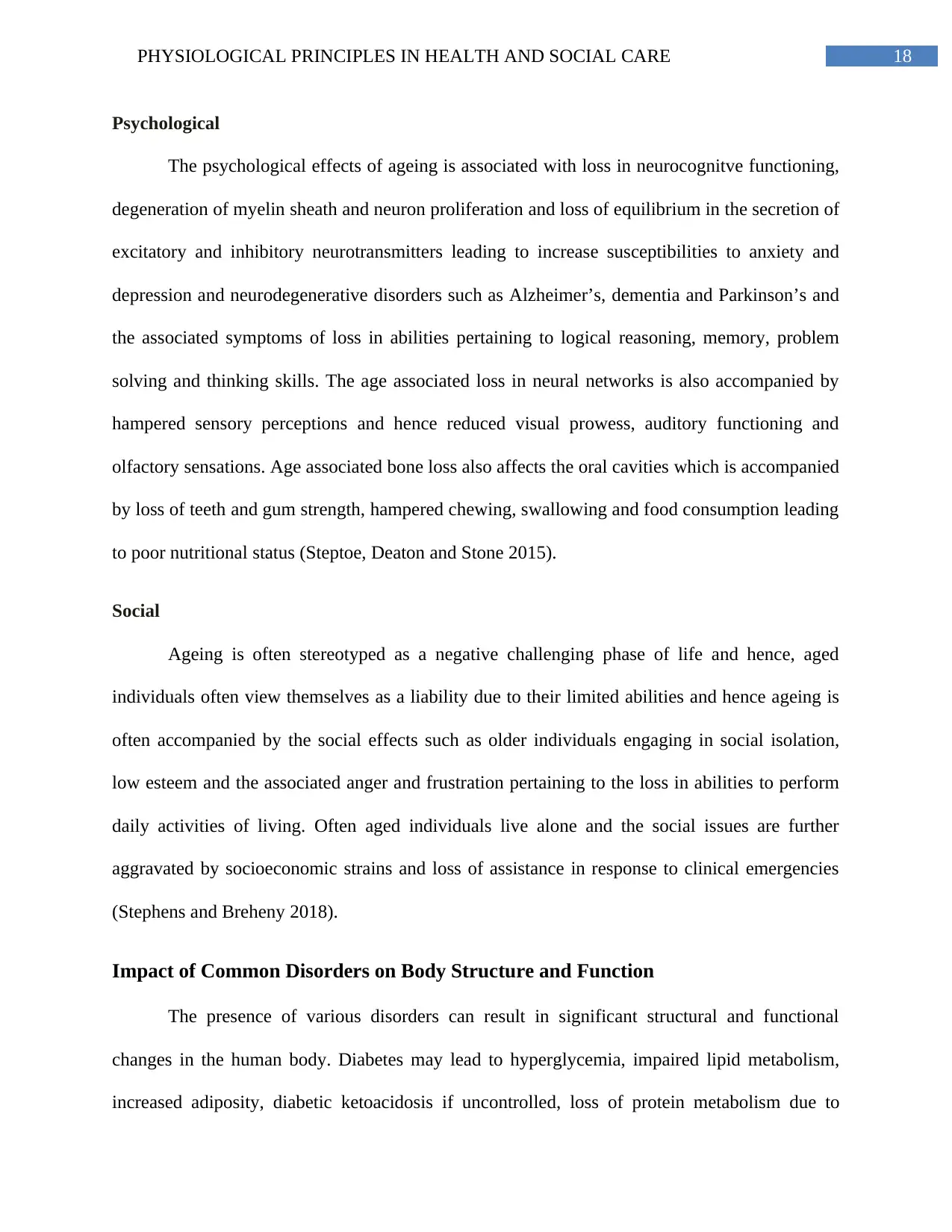
18PHYSIOLOGICAL PRINCIPLES IN HEALTH AND SOCIAL CARE
Psychological
The psychological effects of ageing is associated with loss in neurocognitve functioning,
degeneration of myelin sheath and neuron proliferation and loss of equilibrium in the secretion of
excitatory and inhibitory neurotransmitters leading to increase susceptibilities to anxiety and
depression and neurodegenerative disorders such as Alzheimer’s, dementia and Parkinson’s and
the associated symptoms of loss in abilities pertaining to logical reasoning, memory, problem
solving and thinking skills. The age associated loss in neural networks is also accompanied by
hampered sensory perceptions and hence reduced visual prowess, auditory functioning and
olfactory sensations. Age associated bone loss also affects the oral cavities which is accompanied
by loss of teeth and gum strength, hampered chewing, swallowing and food consumption leading
to poor nutritional status (Steptoe, Deaton and Stone 2015).
Social
Ageing is often stereotyped as a negative challenging phase of life and hence, aged
individuals often view themselves as a liability due to their limited abilities and hence ageing is
often accompanied by the social effects such as older individuals engaging in social isolation,
low esteem and the associated anger and frustration pertaining to the loss in abilities to perform
daily activities of living. Often aged individuals live alone and the social issues are further
aggravated by socioeconomic strains and loss of assistance in response to clinical emergencies
(Stephens and Breheny 2018).
Impact of Common Disorders on Body Structure and Function
The presence of various disorders can result in significant structural and functional
changes in the human body. Diabetes may lead to hyperglycemia, impaired lipid metabolism,
increased adiposity, diabetic ketoacidosis if uncontrolled, loss of protein metabolism due to
Psychological
The psychological effects of ageing is associated with loss in neurocognitve functioning,
degeneration of myelin sheath and neuron proliferation and loss of equilibrium in the secretion of
excitatory and inhibitory neurotransmitters leading to increase susceptibilities to anxiety and
depression and neurodegenerative disorders such as Alzheimer’s, dementia and Parkinson’s and
the associated symptoms of loss in abilities pertaining to logical reasoning, memory, problem
solving and thinking skills. The age associated loss in neural networks is also accompanied by
hampered sensory perceptions and hence reduced visual prowess, auditory functioning and
olfactory sensations. Age associated bone loss also affects the oral cavities which is accompanied
by loss of teeth and gum strength, hampered chewing, swallowing and food consumption leading
to poor nutritional status (Steptoe, Deaton and Stone 2015).
Social
Ageing is often stereotyped as a negative challenging phase of life and hence, aged
individuals often view themselves as a liability due to their limited abilities and hence ageing is
often accompanied by the social effects such as older individuals engaging in social isolation,
low esteem and the associated anger and frustration pertaining to the loss in abilities to perform
daily activities of living. Often aged individuals live alone and the social issues are further
aggravated by socioeconomic strains and loss of assistance in response to clinical emergencies
(Stephens and Breheny 2018).
Impact of Common Disorders on Body Structure and Function
The presence of various disorders can result in significant structural and functional
changes in the human body. Diabetes may lead to hyperglycemia, impaired lipid metabolism,
increased adiposity, diabetic ketoacidosis if uncontrolled, loss of protein metabolism due to
Paraphrase This Document
Need a fresh take? Get an instant paraphrase of this document with our AI Paraphraser
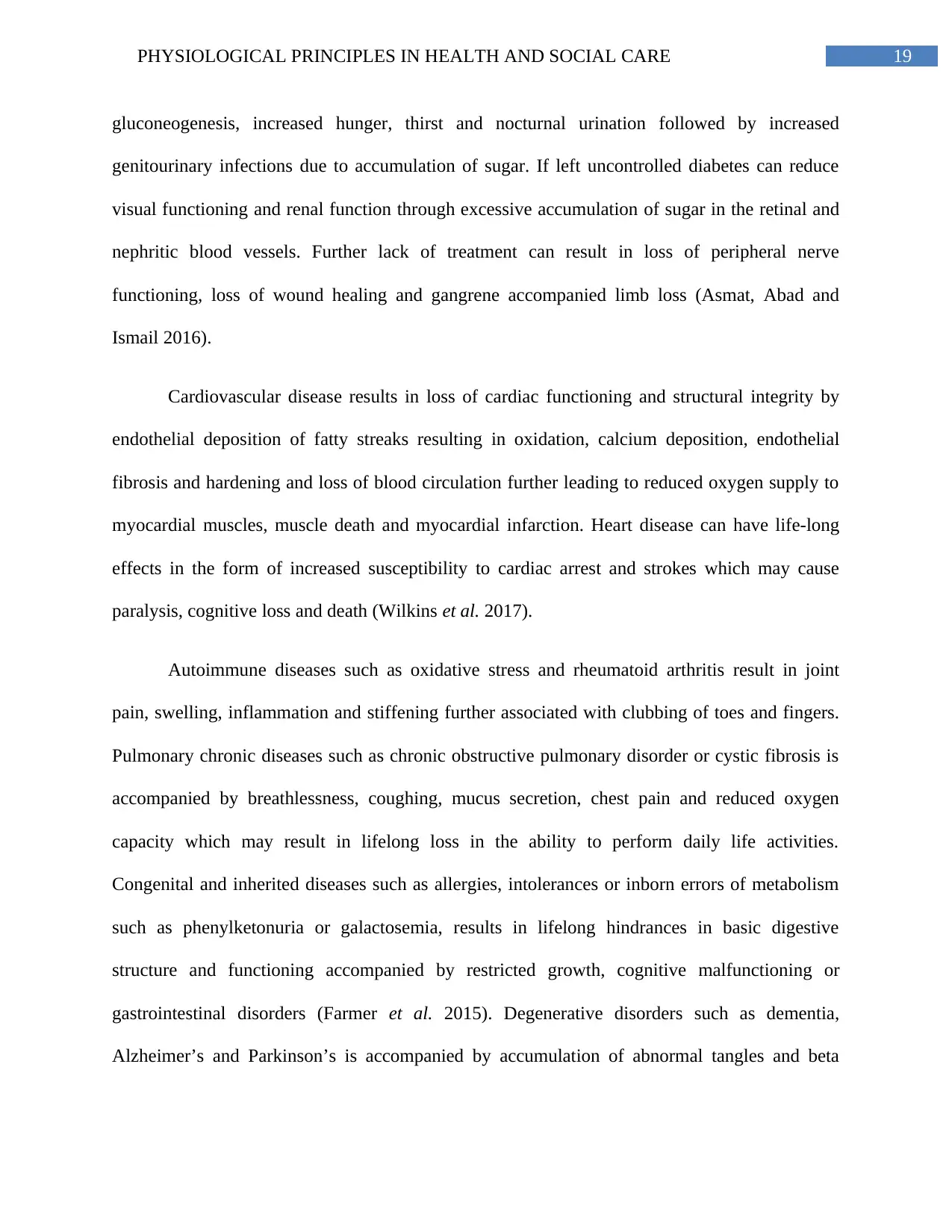
19PHYSIOLOGICAL PRINCIPLES IN HEALTH AND SOCIAL CARE
gluconeogenesis, increased hunger, thirst and nocturnal urination followed by increased
genitourinary infections due to accumulation of sugar. If left uncontrolled diabetes can reduce
visual functioning and renal function through excessive accumulation of sugar in the retinal and
nephritic blood vessels. Further lack of treatment can result in loss of peripheral nerve
functioning, loss of wound healing and gangrene accompanied limb loss (Asmat, Abad and
Ismail 2016).
Cardiovascular disease results in loss of cardiac functioning and structural integrity by
endothelial deposition of fatty streaks resulting in oxidation, calcium deposition, endothelial
fibrosis and hardening and loss of blood circulation further leading to reduced oxygen supply to
myocardial muscles, muscle death and myocardial infarction. Heart disease can have life-long
effects in the form of increased susceptibility to cardiac arrest and strokes which may cause
paralysis, cognitive loss and death (Wilkins et al. 2017).
Autoimmune diseases such as oxidative stress and rheumatoid arthritis result in joint
pain, swelling, inflammation and stiffening further associated with clubbing of toes and fingers.
Pulmonary chronic diseases such as chronic obstructive pulmonary disorder or cystic fibrosis is
accompanied by breathlessness, coughing, mucus secretion, chest pain and reduced oxygen
capacity which may result in lifelong loss in the ability to perform daily life activities.
Congenital and inherited diseases such as allergies, intolerances or inborn errors of metabolism
such as phenylketonuria or galactosemia, results in lifelong hindrances in basic digestive
structure and functioning accompanied by restricted growth, cognitive malfunctioning or
gastrointestinal disorders (Farmer et al. 2015). Degenerative disorders such as dementia,
Alzheimer’s and Parkinson’s is accompanied by accumulation of abnormal tangles and beta
gluconeogenesis, increased hunger, thirst and nocturnal urination followed by increased
genitourinary infections due to accumulation of sugar. If left uncontrolled diabetes can reduce
visual functioning and renal function through excessive accumulation of sugar in the retinal and
nephritic blood vessels. Further lack of treatment can result in loss of peripheral nerve
functioning, loss of wound healing and gangrene accompanied limb loss (Asmat, Abad and
Ismail 2016).
Cardiovascular disease results in loss of cardiac functioning and structural integrity by
endothelial deposition of fatty streaks resulting in oxidation, calcium deposition, endothelial
fibrosis and hardening and loss of blood circulation further leading to reduced oxygen supply to
myocardial muscles, muscle death and myocardial infarction. Heart disease can have life-long
effects in the form of increased susceptibility to cardiac arrest and strokes which may cause
paralysis, cognitive loss and death (Wilkins et al. 2017).
Autoimmune diseases such as oxidative stress and rheumatoid arthritis result in joint
pain, swelling, inflammation and stiffening further associated with clubbing of toes and fingers.
Pulmonary chronic diseases such as chronic obstructive pulmonary disorder or cystic fibrosis is
accompanied by breathlessness, coughing, mucus secretion, chest pain and reduced oxygen
capacity which may result in lifelong loss in the ability to perform daily life activities.
Congenital and inherited diseases such as allergies, intolerances or inborn errors of metabolism
such as phenylketonuria or galactosemia, results in lifelong hindrances in basic digestive
structure and functioning accompanied by restricted growth, cognitive malfunctioning or
gastrointestinal disorders (Farmer et al. 2015). Degenerative disorders such as dementia,
Alzheimer’s and Parkinson’s is accompanied by accumulation of abnormal tangles and beta
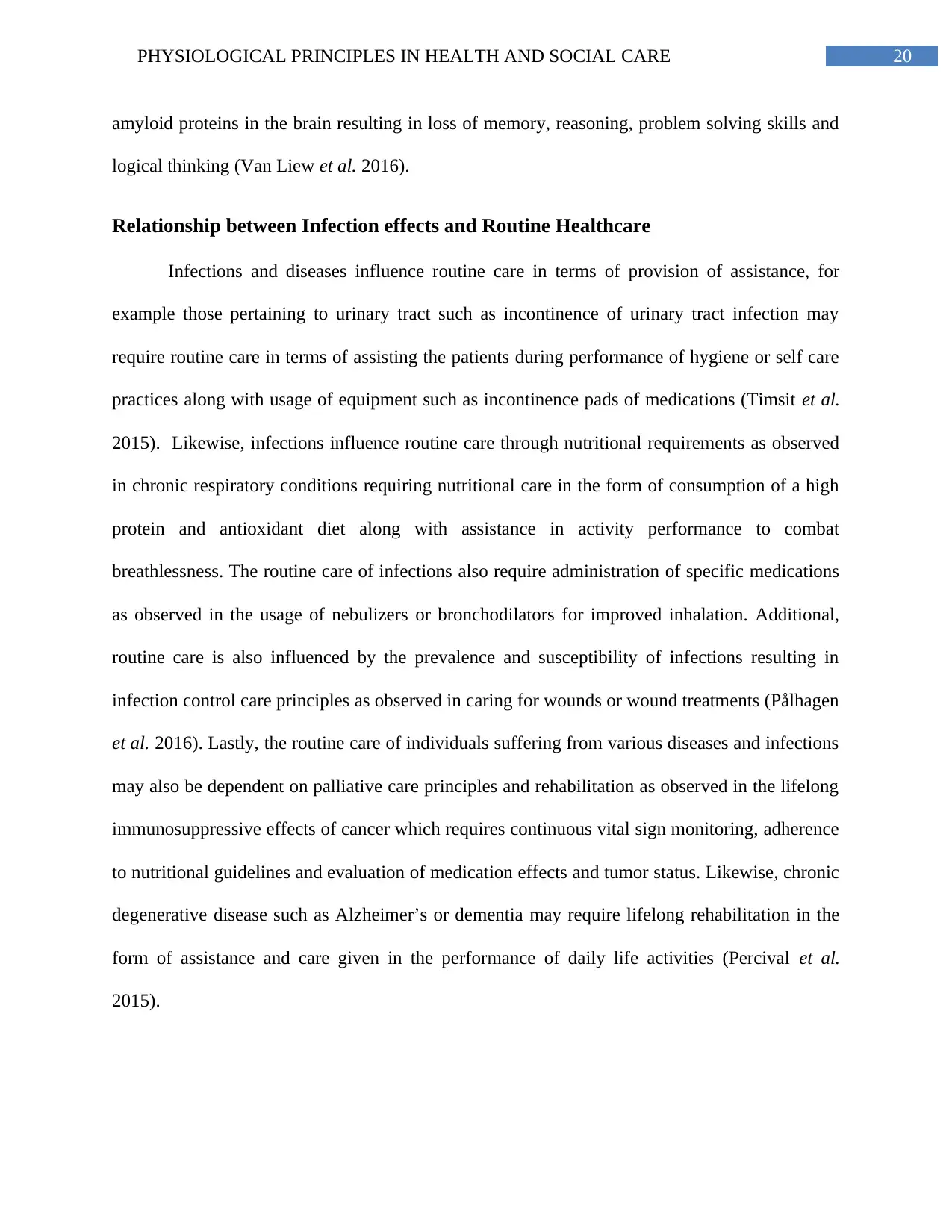
20PHYSIOLOGICAL PRINCIPLES IN HEALTH AND SOCIAL CARE
amyloid proteins in the brain resulting in loss of memory, reasoning, problem solving skills and
logical thinking (Van Liew et al. 2016).
Relationship between Infection effects and Routine Healthcare
Infections and diseases influence routine care in terms of provision of assistance, for
example those pertaining to urinary tract such as incontinence of urinary tract infection may
require routine care in terms of assisting the patients during performance of hygiene or self care
practices along with usage of equipment such as incontinence pads of medications (Timsit et al.
2015). Likewise, infections influence routine care through nutritional requirements as observed
in chronic respiratory conditions requiring nutritional care in the form of consumption of a high
protein and antioxidant diet along with assistance in activity performance to combat
breathlessness. The routine care of infections also require administration of specific medications
as observed in the usage of nebulizers or bronchodilators for improved inhalation. Additional,
routine care is also influenced by the prevalence and susceptibility of infections resulting in
infection control care principles as observed in caring for wounds or wound treatments (Pålhagen
et al. 2016). Lastly, the routine care of individuals suffering from various diseases and infections
may also be dependent on palliative care principles and rehabilitation as observed in the lifelong
immunosuppressive effects of cancer which requires continuous vital sign monitoring, adherence
to nutritional guidelines and evaluation of medication effects and tumor status. Likewise, chronic
degenerative disease such as Alzheimer’s or dementia may require lifelong rehabilitation in the
form of assistance and care given in the performance of daily life activities (Percival et al.
2015).
amyloid proteins in the brain resulting in loss of memory, reasoning, problem solving skills and
logical thinking (Van Liew et al. 2016).
Relationship between Infection effects and Routine Healthcare
Infections and diseases influence routine care in terms of provision of assistance, for
example those pertaining to urinary tract such as incontinence of urinary tract infection may
require routine care in terms of assisting the patients during performance of hygiene or self care
practices along with usage of equipment such as incontinence pads of medications (Timsit et al.
2015). Likewise, infections influence routine care through nutritional requirements as observed
in chronic respiratory conditions requiring nutritional care in the form of consumption of a high
protein and antioxidant diet along with assistance in activity performance to combat
breathlessness. The routine care of infections also require administration of specific medications
as observed in the usage of nebulizers or bronchodilators for improved inhalation. Additional,
routine care is also influenced by the prevalence and susceptibility of infections resulting in
infection control care principles as observed in caring for wounds or wound treatments (Pålhagen
et al. 2016). Lastly, the routine care of individuals suffering from various diseases and infections
may also be dependent on palliative care principles and rehabilitation as observed in the lifelong
immunosuppressive effects of cancer which requires continuous vital sign monitoring, adherence
to nutritional guidelines and evaluation of medication effects and tumor status. Likewise, chronic
degenerative disease such as Alzheimer’s or dementia may require lifelong rehabilitation in the
form of assistance and care given in the performance of daily life activities (Percival et al.
2015).
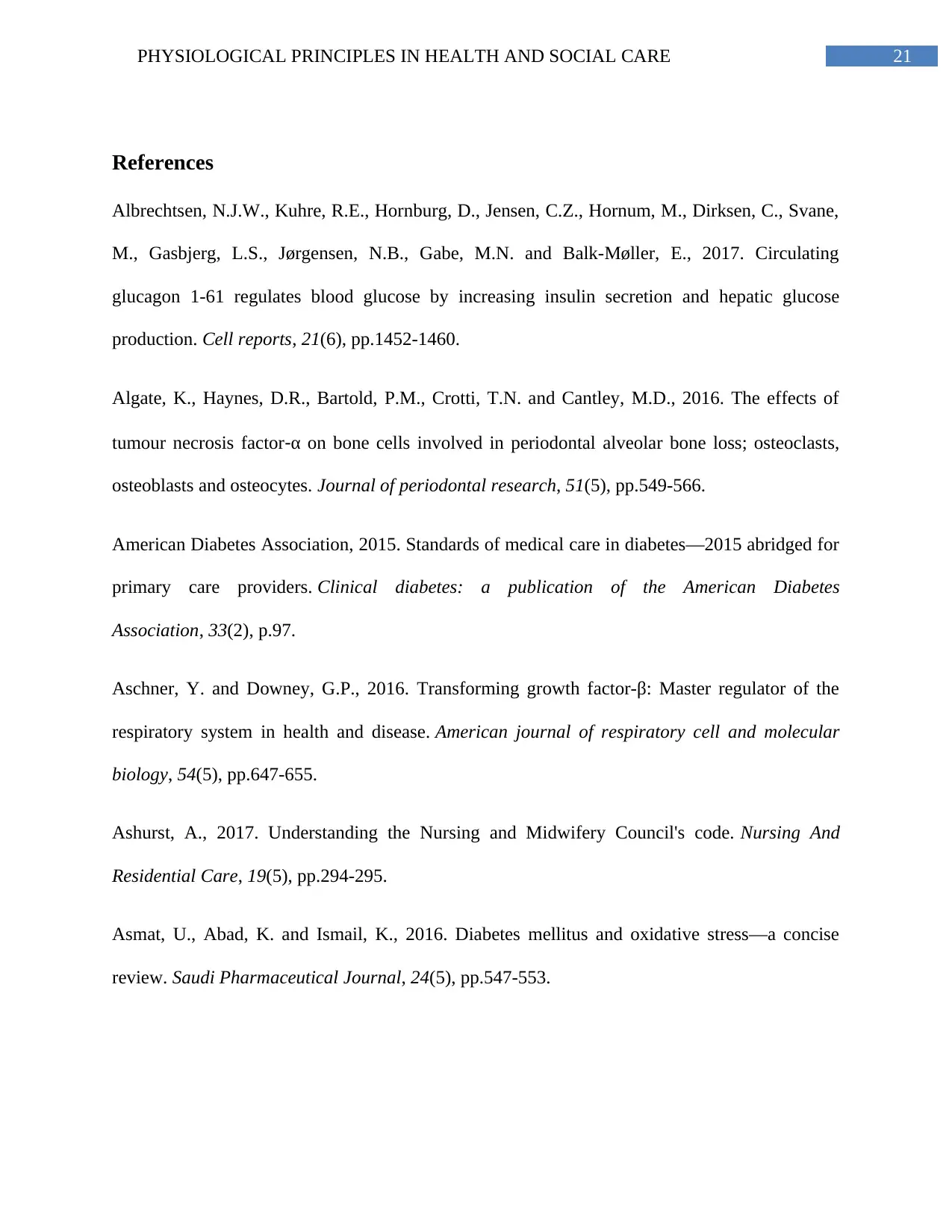
21PHYSIOLOGICAL PRINCIPLES IN HEALTH AND SOCIAL CARE
References
Albrechtsen, N.J.W., Kuhre, R.E., Hornburg, D., Jensen, C.Z., Hornum, M., Dirksen, C., Svane,
M., Gasbjerg, L.S., Jørgensen, N.B., Gabe, M.N. and Balk-Møller, E., 2017. Circulating
glucagon 1-61 regulates blood glucose by increasing insulin secretion and hepatic glucose
production. Cell reports, 21(6), pp.1452-1460.
Algate, K., Haynes, D.R., Bartold, P.M., Crotti, T.N. and Cantley, M.D., 2016. The effects of
tumour necrosis factor‐α on bone cells involved in periodontal alveolar bone loss; osteoclasts,
osteoblasts and osteocytes. Journal of periodontal research, 51(5), pp.549-566.
American Diabetes Association, 2015. Standards of medical care in diabetes—2015 abridged for
primary care providers. Clinical diabetes: a publication of the American Diabetes
Association, 33(2), p.97.
Aschner, Y. and Downey, G.P., 2016. Transforming growth factor-β: Master regulator of the
respiratory system in health and disease. American journal of respiratory cell and molecular
biology, 54(5), pp.647-655.
Ashurst, A., 2017. Understanding the Nursing and Midwifery Council's code. Nursing And
Residential Care, 19(5), pp.294-295.
Asmat, U., Abad, K. and Ismail, K., 2016. Diabetes mellitus and oxidative stress—a concise
review. Saudi Pharmaceutical Journal, 24(5), pp.547-553.
References
Albrechtsen, N.J.W., Kuhre, R.E., Hornburg, D., Jensen, C.Z., Hornum, M., Dirksen, C., Svane,
M., Gasbjerg, L.S., Jørgensen, N.B., Gabe, M.N. and Balk-Møller, E., 2017. Circulating
glucagon 1-61 regulates blood glucose by increasing insulin secretion and hepatic glucose
production. Cell reports, 21(6), pp.1452-1460.
Algate, K., Haynes, D.R., Bartold, P.M., Crotti, T.N. and Cantley, M.D., 2016. The effects of
tumour necrosis factor‐α on bone cells involved in periodontal alveolar bone loss; osteoclasts,
osteoblasts and osteocytes. Journal of periodontal research, 51(5), pp.549-566.
American Diabetes Association, 2015. Standards of medical care in diabetes—2015 abridged for
primary care providers. Clinical diabetes: a publication of the American Diabetes
Association, 33(2), p.97.
Aschner, Y. and Downey, G.P., 2016. Transforming growth factor-β: Master regulator of the
respiratory system in health and disease. American journal of respiratory cell and molecular
biology, 54(5), pp.647-655.
Ashurst, A., 2017. Understanding the Nursing and Midwifery Council's code. Nursing And
Residential Care, 19(5), pp.294-295.
Asmat, U., Abad, K. and Ismail, K., 2016. Diabetes mellitus and oxidative stress—a concise
review. Saudi Pharmaceutical Journal, 24(5), pp.547-553.
Secure Best Marks with AI Grader
Need help grading? Try our AI Grader for instant feedback on your assignments.
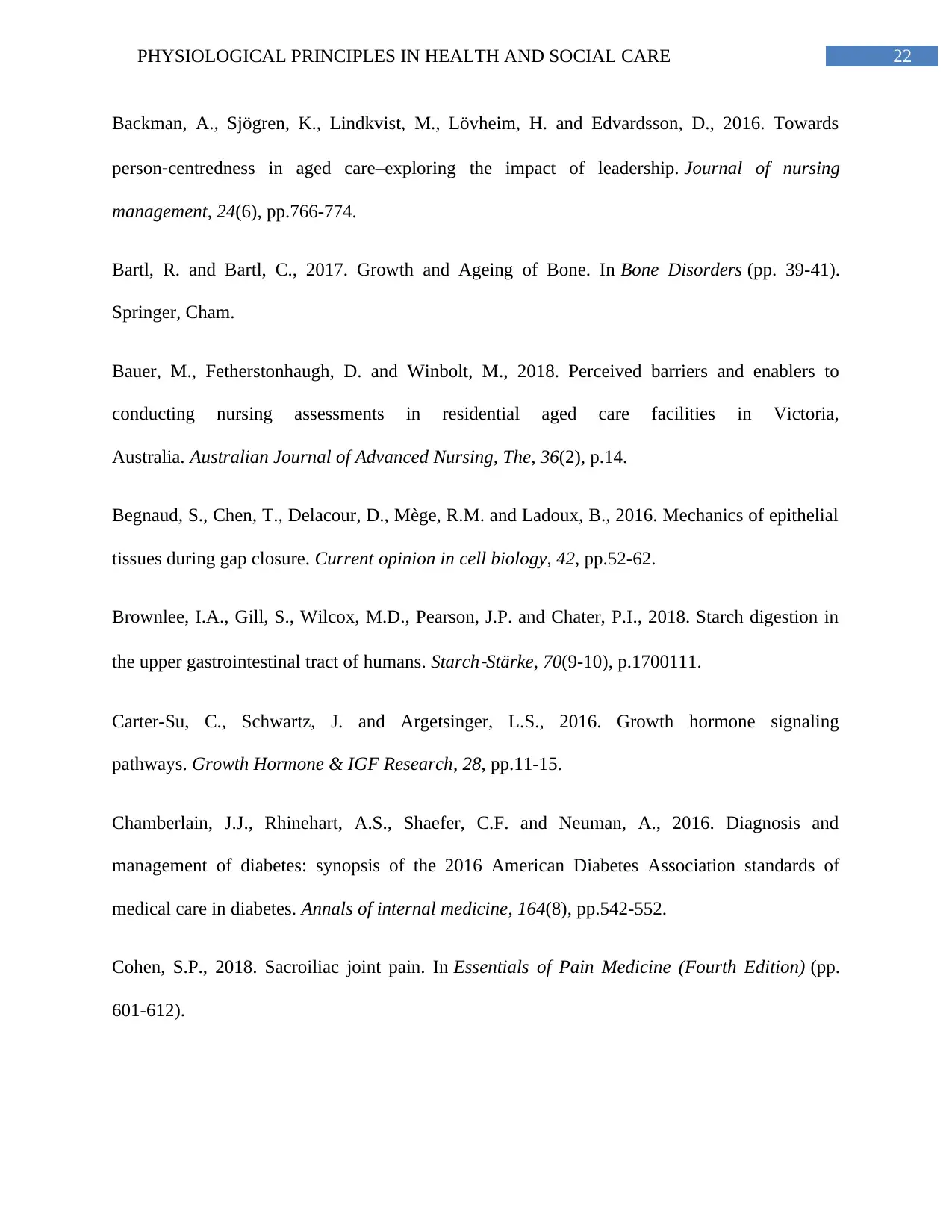
22PHYSIOLOGICAL PRINCIPLES IN HEALTH AND SOCIAL CARE
Backman, A., Sjögren, K., Lindkvist, M., Lövheim, H. and Edvardsson, D., 2016. Towards
person‐centredness in aged care–exploring the impact of leadership. Journal of nursing
management, 24(6), pp.766-774.
Bartl, R. and Bartl, C., 2017. Growth and Ageing of Bone. In Bone Disorders (pp. 39-41).
Springer, Cham.
Bauer, M., Fetherstonhaugh, D. and Winbolt, M., 2018. Perceived barriers and enablers to
conducting nursing assessments in residential aged care facilities in Victoria,
Australia. Australian Journal of Advanced Nursing, The, 36(2), p.14.
Begnaud, S., Chen, T., Delacour, D., Mège, R.M. and Ladoux, B., 2016. Mechanics of epithelial
tissues during gap closure. Current opinion in cell biology, 42, pp.52-62.
Brownlee, I.A., Gill, S., Wilcox, M.D., Pearson, J.P. and Chater, P.I., 2018. Starch digestion in
the upper gastrointestinal tract of humans. Starch
‐Stärke, 70(9-10), p.1700111.
Carter-Su, C., Schwartz, J. and Argetsinger, L.S., 2016. Growth hormone signaling
pathways. Growth Hormone & IGF Research, 28, pp.11-15.
Chamberlain, J.J., Rhinehart, A.S., Shaefer, C.F. and Neuman, A., 2016. Diagnosis and
management of diabetes: synopsis of the 2016 American Diabetes Association standards of
medical care in diabetes. Annals of internal medicine, 164(8), pp.542-552.
Cohen, S.P., 2018. Sacroiliac joint pain. In Essentials of Pain Medicine (Fourth Edition) (pp.
601-612).
Backman, A., Sjögren, K., Lindkvist, M., Lövheim, H. and Edvardsson, D., 2016. Towards
person‐centredness in aged care–exploring the impact of leadership. Journal of nursing
management, 24(6), pp.766-774.
Bartl, R. and Bartl, C., 2017. Growth and Ageing of Bone. In Bone Disorders (pp. 39-41).
Springer, Cham.
Bauer, M., Fetherstonhaugh, D. and Winbolt, M., 2018. Perceived barriers and enablers to
conducting nursing assessments in residential aged care facilities in Victoria,
Australia. Australian Journal of Advanced Nursing, The, 36(2), p.14.
Begnaud, S., Chen, T., Delacour, D., Mège, R.M. and Ladoux, B., 2016. Mechanics of epithelial
tissues during gap closure. Current opinion in cell biology, 42, pp.52-62.
Brownlee, I.A., Gill, S., Wilcox, M.D., Pearson, J.P. and Chater, P.I., 2018. Starch digestion in
the upper gastrointestinal tract of humans. Starch
‐Stärke, 70(9-10), p.1700111.
Carter-Su, C., Schwartz, J. and Argetsinger, L.S., 2016. Growth hormone signaling
pathways. Growth Hormone & IGF Research, 28, pp.11-15.
Chamberlain, J.J., Rhinehart, A.S., Shaefer, C.F. and Neuman, A., 2016. Diagnosis and
management of diabetes: synopsis of the 2016 American Diabetes Association standards of
medical care in diabetes. Annals of internal medicine, 164(8), pp.542-552.
Cohen, S.P., 2018. Sacroiliac joint pain. In Essentials of Pain Medicine (Fourth Edition) (pp.
601-612).

23PHYSIOLOGICAL PRINCIPLES IN HEALTH AND SOCIAL CARE
Couto, N., Wood, J. and Barber, J., 2016. The role of glutathione reductase and related enzymes
on cellular redox homoeostasis network. Free radical biology and medicine, 95, pp.27-42.
Creighton, A.S., Davison, T.E. and Kissane, D.W., 2018. The assessment of anxiety in aged care
residents: A systematic review of the psychometric properties of commonly used
measures. International psychogeriatrics, 30(7), pp.967-979.
Cullen-McEwen, L., Sutherland, M.R. and Black, M.J., 2016. The human kidney: parallels in
structure, spatial development, and timing of nephrogenesis. In Kidney development, disease,
repair and regeneration (pp. 27-40).
Dey, S., Chamero, P., Pru, J.K., Chien, M.S., Ibarra-Soria, X., Spencer, K.R., Logan, D.W.,
Matsunami, H., Peluso, J.J. and Stowers, L., 2015. Cyclic regulation of sensory perception by a
female hormone alters behavior. Cell, 161(6), pp.1334-1344.
Douglas, H.E., Georgiou, A., Tariq, A., Prgomet, M., Warland, A., Armour, P. and Westbrook,
J.I., 2017. Implementing information and communication technology to support community aged
care service integration: Lessons from an Australian aged care provider. International journal of
integrated care, 17(1).
El-Jawhari, J., Ganguly, P., Burska, A., Ponchel, F., Giannoudis, P. and Jones, E., 2017. Towards
understanding healthy ageing of bone marrow resident multipotential stromal
cells. Cytotherapy, 19(5), p.S155.
Epstein, M., Reaven, N.L., Funk, S.E., McGaughey, K.J., Oestreicher, N. and Knispel, J., 2015.
Evaluation of the treatment gap between clinical guidelines and the utilization of renin-
angiotensin-aldosterone system inhibitors. Am J Manag Care, 21(11 Suppl), pp.S212-S220.
Couto, N., Wood, J. and Barber, J., 2016. The role of glutathione reductase and related enzymes
on cellular redox homoeostasis network. Free radical biology and medicine, 95, pp.27-42.
Creighton, A.S., Davison, T.E. and Kissane, D.W., 2018. The assessment of anxiety in aged care
residents: A systematic review of the psychometric properties of commonly used
measures. International psychogeriatrics, 30(7), pp.967-979.
Cullen-McEwen, L., Sutherland, M.R. and Black, M.J., 2016. The human kidney: parallels in
structure, spatial development, and timing of nephrogenesis. In Kidney development, disease,
repair and regeneration (pp. 27-40).
Dey, S., Chamero, P., Pru, J.K., Chien, M.S., Ibarra-Soria, X., Spencer, K.R., Logan, D.W.,
Matsunami, H., Peluso, J.J. and Stowers, L., 2015. Cyclic regulation of sensory perception by a
female hormone alters behavior. Cell, 161(6), pp.1334-1344.
Douglas, H.E., Georgiou, A., Tariq, A., Prgomet, M., Warland, A., Armour, P. and Westbrook,
J.I., 2017. Implementing information and communication technology to support community aged
care service integration: Lessons from an Australian aged care provider. International journal of
integrated care, 17(1).
El-Jawhari, J., Ganguly, P., Burska, A., Ponchel, F., Giannoudis, P. and Jones, E., 2017. Towards
understanding healthy ageing of bone marrow resident multipotential stromal
cells. Cytotherapy, 19(5), p.S155.
Epstein, M., Reaven, N.L., Funk, S.E., McGaughey, K.J., Oestreicher, N. and Knispel, J., 2015.
Evaluation of the treatment gap between clinical guidelines and the utilization of renin-
angiotensin-aldosterone system inhibitors. Am J Manag Care, 21(11 Suppl), pp.S212-S220.
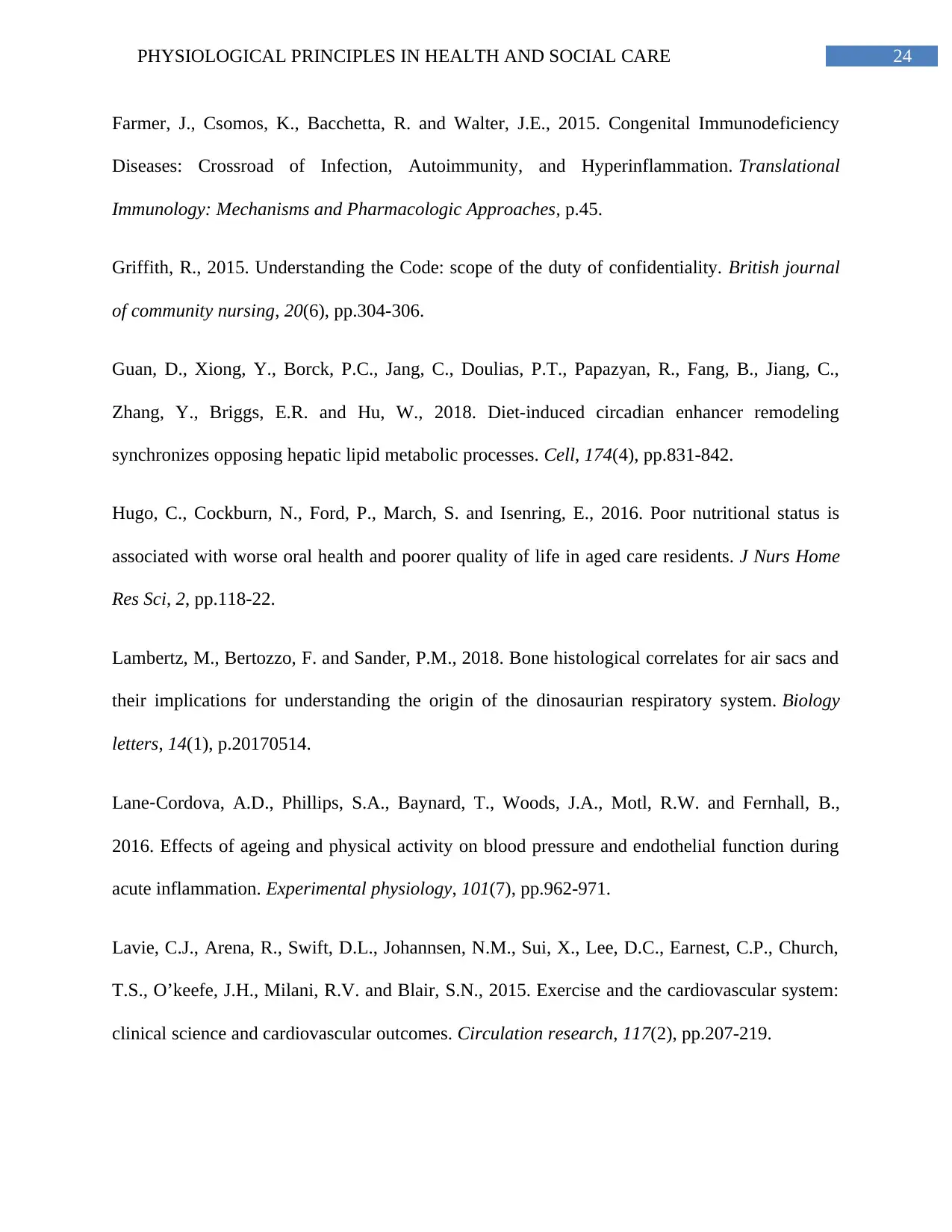
24PHYSIOLOGICAL PRINCIPLES IN HEALTH AND SOCIAL CARE
Farmer, J., Csomos, K., Bacchetta, R. and Walter, J.E., 2015. Congenital Immunodeficiency
Diseases: Crossroad of Infection, Autoimmunity, and Hyperinflammation. Translational
Immunology: Mechanisms and Pharmacologic Approaches, p.45.
Griffith, R., 2015. Understanding the Code: scope of the duty of confidentiality. British journal
of community nursing, 20(6), pp.304-306.
Guan, D., Xiong, Y., Borck, P.C., Jang, C., Doulias, P.T., Papazyan, R., Fang, B., Jiang, C.,
Zhang, Y., Briggs, E.R. and Hu, W., 2018. Diet-induced circadian enhancer remodeling
synchronizes opposing hepatic lipid metabolic processes. Cell, 174(4), pp.831-842.
Hugo, C., Cockburn, N., Ford, P., March, S. and Isenring, E., 2016. Poor nutritional status is
associated with worse oral health and poorer quality of life in aged care residents. J Nurs Home
Res Sci, 2, pp.118-22.
Lambertz, M., Bertozzo, F. and Sander, P.M., 2018. Bone histological correlates for air sacs and
their implications for understanding the origin of the dinosaurian respiratory system. Biology
letters, 14(1), p.20170514.
Lane‐Cordova, A.D., Phillips, S.A., Baynard, T., Woods, J.A., Motl, R.W. and Fernhall, B.,
2016. Effects of ageing and physical activity on blood pressure and endothelial function during
acute inflammation. Experimental physiology, 101(7), pp.962-971.
Lavie, C.J., Arena, R., Swift, D.L., Johannsen, N.M., Sui, X., Lee, D.C., Earnest, C.P., Church,
T.S., O’keefe, J.H., Milani, R.V. and Blair, S.N., 2015. Exercise and the cardiovascular system:
clinical science and cardiovascular outcomes. Circulation research, 117(2), pp.207-219.
Farmer, J., Csomos, K., Bacchetta, R. and Walter, J.E., 2015. Congenital Immunodeficiency
Diseases: Crossroad of Infection, Autoimmunity, and Hyperinflammation. Translational
Immunology: Mechanisms and Pharmacologic Approaches, p.45.
Griffith, R., 2015. Understanding the Code: scope of the duty of confidentiality. British journal
of community nursing, 20(6), pp.304-306.
Guan, D., Xiong, Y., Borck, P.C., Jang, C., Doulias, P.T., Papazyan, R., Fang, B., Jiang, C.,
Zhang, Y., Briggs, E.R. and Hu, W., 2018. Diet-induced circadian enhancer remodeling
synchronizes opposing hepatic lipid metabolic processes. Cell, 174(4), pp.831-842.
Hugo, C., Cockburn, N., Ford, P., March, S. and Isenring, E., 2016. Poor nutritional status is
associated with worse oral health and poorer quality of life in aged care residents. J Nurs Home
Res Sci, 2, pp.118-22.
Lambertz, M., Bertozzo, F. and Sander, P.M., 2018. Bone histological correlates for air sacs and
their implications for understanding the origin of the dinosaurian respiratory system. Biology
letters, 14(1), p.20170514.
Lane‐Cordova, A.D., Phillips, S.A., Baynard, T., Woods, J.A., Motl, R.W. and Fernhall, B.,
2016. Effects of ageing and physical activity on blood pressure and endothelial function during
acute inflammation. Experimental physiology, 101(7), pp.962-971.
Lavie, C.J., Arena, R., Swift, D.L., Johannsen, N.M., Sui, X., Lee, D.C., Earnest, C.P., Church,
T.S., O’keefe, J.H., Milani, R.V. and Blair, S.N., 2015. Exercise and the cardiovascular system:
clinical science and cardiovascular outcomes. Circulation research, 117(2), pp.207-219.
Paraphrase This Document
Need a fresh take? Get an instant paraphrase of this document with our AI Paraphraser
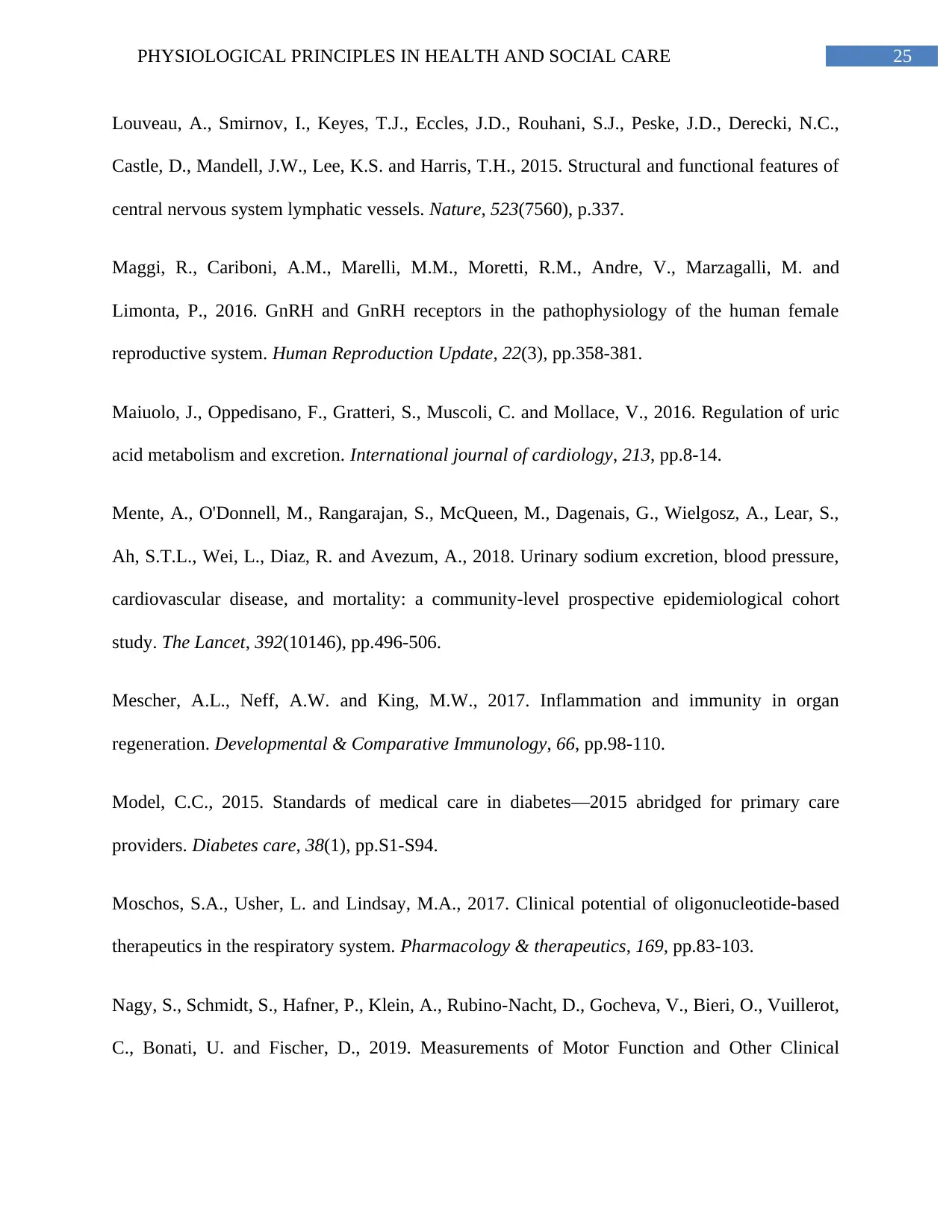
25PHYSIOLOGICAL PRINCIPLES IN HEALTH AND SOCIAL CARE
Louveau, A., Smirnov, I., Keyes, T.J., Eccles, J.D., Rouhani, S.J., Peske, J.D., Derecki, N.C.,
Castle, D., Mandell, J.W., Lee, K.S. and Harris, T.H., 2015. Structural and functional features of
central nervous system lymphatic vessels. Nature, 523(7560), p.337.
Maggi, R., Cariboni, A.M., Marelli, M.M., Moretti, R.M., Andre, V., Marzagalli, M. and
Limonta, P., 2016. GnRH and GnRH receptors in the pathophysiology of the human female
reproductive system. Human Reproduction Update, 22(3), pp.358-381.
Maiuolo, J., Oppedisano, F., Gratteri, S., Muscoli, C. and Mollace, V., 2016. Regulation of uric
acid metabolism and excretion. International journal of cardiology, 213, pp.8-14.
Mente, A., O'Donnell, M., Rangarajan, S., McQueen, M., Dagenais, G., Wielgosz, A., Lear, S.,
Ah, S.T.L., Wei, L., Diaz, R. and Avezum, A., 2018. Urinary sodium excretion, blood pressure,
cardiovascular disease, and mortality: a community-level prospective epidemiological cohort
study. The Lancet, 392(10146), pp.496-506.
Mescher, A.L., Neff, A.W. and King, M.W., 2017. Inflammation and immunity in organ
regeneration. Developmental & Comparative Immunology, 66, pp.98-110.
Model, C.C., 2015. Standards of medical care in diabetes—2015 abridged for primary care
providers. Diabetes care, 38(1), pp.S1-S94.
Moschos, S.A., Usher, L. and Lindsay, M.A., 2017. Clinical potential of oligonucleotide-based
therapeutics in the respiratory system. Pharmacology & therapeutics, 169, pp.83-103.
Nagy, S., Schmidt, S., Hafner, P., Klein, A., Rubino-Nacht, D., Gocheva, V., Bieri, O., Vuillerot,
C., Bonati, U. and Fischer, D., 2019. Measurements of Motor Function and Other Clinical
Louveau, A., Smirnov, I., Keyes, T.J., Eccles, J.D., Rouhani, S.J., Peske, J.D., Derecki, N.C.,
Castle, D., Mandell, J.W., Lee, K.S. and Harris, T.H., 2015. Structural and functional features of
central nervous system lymphatic vessels. Nature, 523(7560), p.337.
Maggi, R., Cariboni, A.M., Marelli, M.M., Moretti, R.M., Andre, V., Marzagalli, M. and
Limonta, P., 2016. GnRH and GnRH receptors in the pathophysiology of the human female
reproductive system. Human Reproduction Update, 22(3), pp.358-381.
Maiuolo, J., Oppedisano, F., Gratteri, S., Muscoli, C. and Mollace, V., 2016. Regulation of uric
acid metabolism and excretion. International journal of cardiology, 213, pp.8-14.
Mente, A., O'Donnell, M., Rangarajan, S., McQueen, M., Dagenais, G., Wielgosz, A., Lear, S.,
Ah, S.T.L., Wei, L., Diaz, R. and Avezum, A., 2018. Urinary sodium excretion, blood pressure,
cardiovascular disease, and mortality: a community-level prospective epidemiological cohort
study. The Lancet, 392(10146), pp.496-506.
Mescher, A.L., Neff, A.W. and King, M.W., 2017. Inflammation and immunity in organ
regeneration. Developmental & Comparative Immunology, 66, pp.98-110.
Model, C.C., 2015. Standards of medical care in diabetes—2015 abridged for primary care
providers. Diabetes care, 38(1), pp.S1-S94.
Moschos, S.A., Usher, L. and Lindsay, M.A., 2017. Clinical potential of oligonucleotide-based
therapeutics in the respiratory system. Pharmacology & therapeutics, 169, pp.83-103.
Nagy, S., Schmidt, S., Hafner, P., Klein, A., Rubino-Nacht, D., Gocheva, V., Bieri, O., Vuillerot,
C., Bonati, U. and Fischer, D., 2019. Measurements of Motor Function and Other Clinical
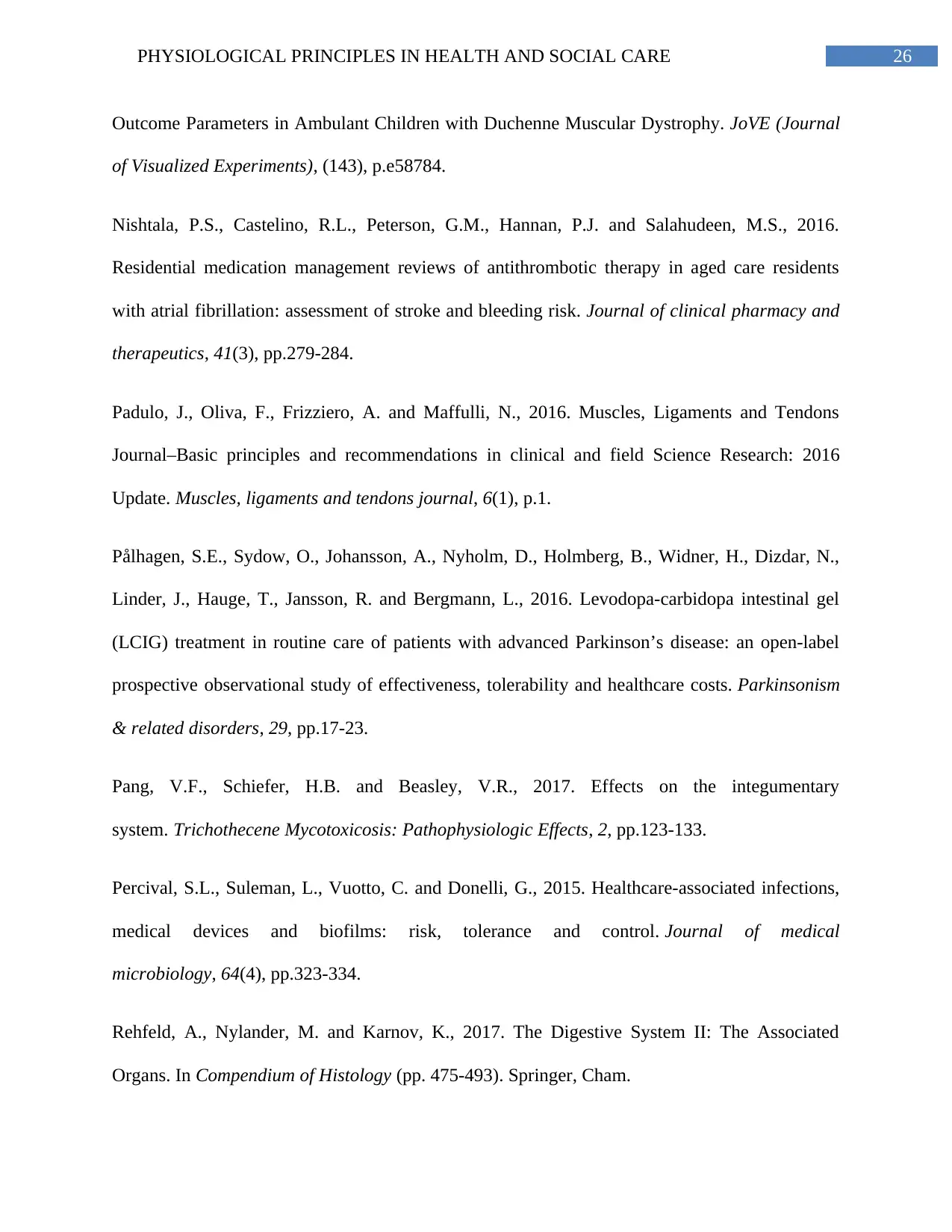
26PHYSIOLOGICAL PRINCIPLES IN HEALTH AND SOCIAL CARE
Outcome Parameters in Ambulant Children with Duchenne Muscular Dystrophy. JoVE (Journal
of Visualized Experiments), (143), p.e58784.
Nishtala, P.S., Castelino, R.L., Peterson, G.M., Hannan, P.J. and Salahudeen, M.S., 2016.
Residential medication management reviews of antithrombotic therapy in aged care residents
with atrial fibrillation: assessment of stroke and bleeding risk. Journal of clinical pharmacy and
therapeutics, 41(3), pp.279-284.
Padulo, J., Oliva, F., Frizziero, A. and Maffulli, N., 2016. Muscles, Ligaments and Tendons
Journal–Basic principles and recommendations in clinical and field Science Research: 2016
Update. Muscles, ligaments and tendons journal, 6(1), p.1.
Pålhagen, S.E., Sydow, O., Johansson, A., Nyholm, D., Holmberg, B., Widner, H., Dizdar, N.,
Linder, J., Hauge, T., Jansson, R. and Bergmann, L., 2016. Levodopa-carbidopa intestinal gel
(LCIG) treatment in routine care of patients with advanced Parkinson’s disease: an open-label
prospective observational study of effectiveness, tolerability and healthcare costs. Parkinsonism
& related disorders, 29, pp.17-23.
Pang, V.F., Schiefer, H.B. and Beasley, V.R., 2017. Effects on the integumentary
system. Trichothecene Mycotoxicosis: Pathophysiologic Effects, 2, pp.123-133.
Percival, S.L., Suleman, L., Vuotto, C. and Donelli, G., 2015. Healthcare-associated infections,
medical devices and biofilms: risk, tolerance and control. Journal of medical
microbiology, 64(4), pp.323-334.
Rehfeld, A., Nylander, M. and Karnov, K., 2017. The Digestive System II: The Associated
Organs. In Compendium of Histology (pp. 475-493). Springer, Cham.
Outcome Parameters in Ambulant Children with Duchenne Muscular Dystrophy. JoVE (Journal
of Visualized Experiments), (143), p.e58784.
Nishtala, P.S., Castelino, R.L., Peterson, G.M., Hannan, P.J. and Salahudeen, M.S., 2016.
Residential medication management reviews of antithrombotic therapy in aged care residents
with atrial fibrillation: assessment of stroke and bleeding risk. Journal of clinical pharmacy and
therapeutics, 41(3), pp.279-284.
Padulo, J., Oliva, F., Frizziero, A. and Maffulli, N., 2016. Muscles, Ligaments and Tendons
Journal–Basic principles and recommendations in clinical and field Science Research: 2016
Update. Muscles, ligaments and tendons journal, 6(1), p.1.
Pålhagen, S.E., Sydow, O., Johansson, A., Nyholm, D., Holmberg, B., Widner, H., Dizdar, N.,
Linder, J., Hauge, T., Jansson, R. and Bergmann, L., 2016. Levodopa-carbidopa intestinal gel
(LCIG) treatment in routine care of patients with advanced Parkinson’s disease: an open-label
prospective observational study of effectiveness, tolerability and healthcare costs. Parkinsonism
& related disorders, 29, pp.17-23.
Pang, V.F., Schiefer, H.B. and Beasley, V.R., 2017. Effects on the integumentary
system. Trichothecene Mycotoxicosis: Pathophysiologic Effects, 2, pp.123-133.
Percival, S.L., Suleman, L., Vuotto, C. and Donelli, G., 2015. Healthcare-associated infections,
medical devices and biofilms: risk, tolerance and control. Journal of medical
microbiology, 64(4), pp.323-334.
Rehfeld, A., Nylander, M. and Karnov, K., 2017. The Digestive System II: The Associated
Organs. In Compendium of Histology (pp. 475-493). Springer, Cham.

27PHYSIOLOGICAL PRINCIPLES IN HEALTH AND SOCIAL CARE
Rohner-Jeanrenaud, F. and Nogueiras, R., 2015. Endocrine control of energy
homeostasis. Molecular and cellular endocrinology, 418, pp.1-2.
Salleck, D. and John, S., 2017. Organ Interactions: Heart and kidney. Deutsche medizinische
Wochenschrift (1946), 142(18), pp.1348-1356.
Seals, D.R., Justice, J.N. and LaRocca, T.J., 2016. Physiological geroscience: targeting function
to increase healthspan and achieve optimal longevity. The Journal of physiology, 594(8),
pp.2001-2024.
Seror, J., Zhu, L., Goldberg, R., Day, A.J. and Klein, J., 2015. Supramolecular synergy in the
boundary lubrication of synovial joints. Nature communications, 6, p.6497.
Sheehan, F.T., Brainerd, E.L., Troy, K.L., Shefelbine, S.J. and Ronsky, J.L., 2018. Advancing
quantitative techniques to improve understanding of the skeletal structure-function
relationship. Journal of neuroengineering and rehabilitation, 15(1), p.25.
Song, J., Ampatzis, K., Björnfors, E.R. and El Manira, A., 2016. Motor neurons control
locomotor circuit function retrogradely via gap junctions. Nature, 529(7586), p.399.
Stapley, S.A., Rubin, G.P., Alsina, D., Shephard, E.A., Rutter, M.D. and Hamilton, W.T., 2017.
Clinical features of bowel disease in patients aged< 50 years in primary care: a large case-control
study. Br J Gen Pract, p.bjgp17X690425.
Stathopoulos, K. D., A. B. Zoubos, N. A. Papaioannou, D. Mastrokalos, A. Galanos, P. J.
Papagelopoulos, and G. Skarantavos. "Differences of bone mineral mass, volumetric bone
mineral density, geometrical and structural parameters and derived strength of the tibia between
premenopausal and postmenopausal women of different age groups: a peripheral Quantitative
Rohner-Jeanrenaud, F. and Nogueiras, R., 2015. Endocrine control of energy
homeostasis. Molecular and cellular endocrinology, 418, pp.1-2.
Salleck, D. and John, S., 2017. Organ Interactions: Heart and kidney. Deutsche medizinische
Wochenschrift (1946), 142(18), pp.1348-1356.
Seals, D.R., Justice, J.N. and LaRocca, T.J., 2016. Physiological geroscience: targeting function
to increase healthspan and achieve optimal longevity. The Journal of physiology, 594(8),
pp.2001-2024.
Seror, J., Zhu, L., Goldberg, R., Day, A.J. and Klein, J., 2015. Supramolecular synergy in the
boundary lubrication of synovial joints. Nature communications, 6, p.6497.
Sheehan, F.T., Brainerd, E.L., Troy, K.L., Shefelbine, S.J. and Ronsky, J.L., 2018. Advancing
quantitative techniques to improve understanding of the skeletal structure-function
relationship. Journal of neuroengineering and rehabilitation, 15(1), p.25.
Song, J., Ampatzis, K., Björnfors, E.R. and El Manira, A., 2016. Motor neurons control
locomotor circuit function retrogradely via gap junctions. Nature, 529(7586), p.399.
Stapley, S.A., Rubin, G.P., Alsina, D., Shephard, E.A., Rutter, M.D. and Hamilton, W.T., 2017.
Clinical features of bowel disease in patients aged< 50 years in primary care: a large case-control
study. Br J Gen Pract, p.bjgp17X690425.
Stathopoulos, K. D., A. B. Zoubos, N. A. Papaioannou, D. Mastrokalos, A. Galanos, P. J.
Papagelopoulos, and G. Skarantavos. "Differences of bone mineral mass, volumetric bone
mineral density, geometrical and structural parameters and derived strength of the tibia between
premenopausal and postmenopausal women of different age groups: a peripheral Quantitative
Secure Best Marks with AI Grader
Need help grading? Try our AI Grader for instant feedback on your assignments.
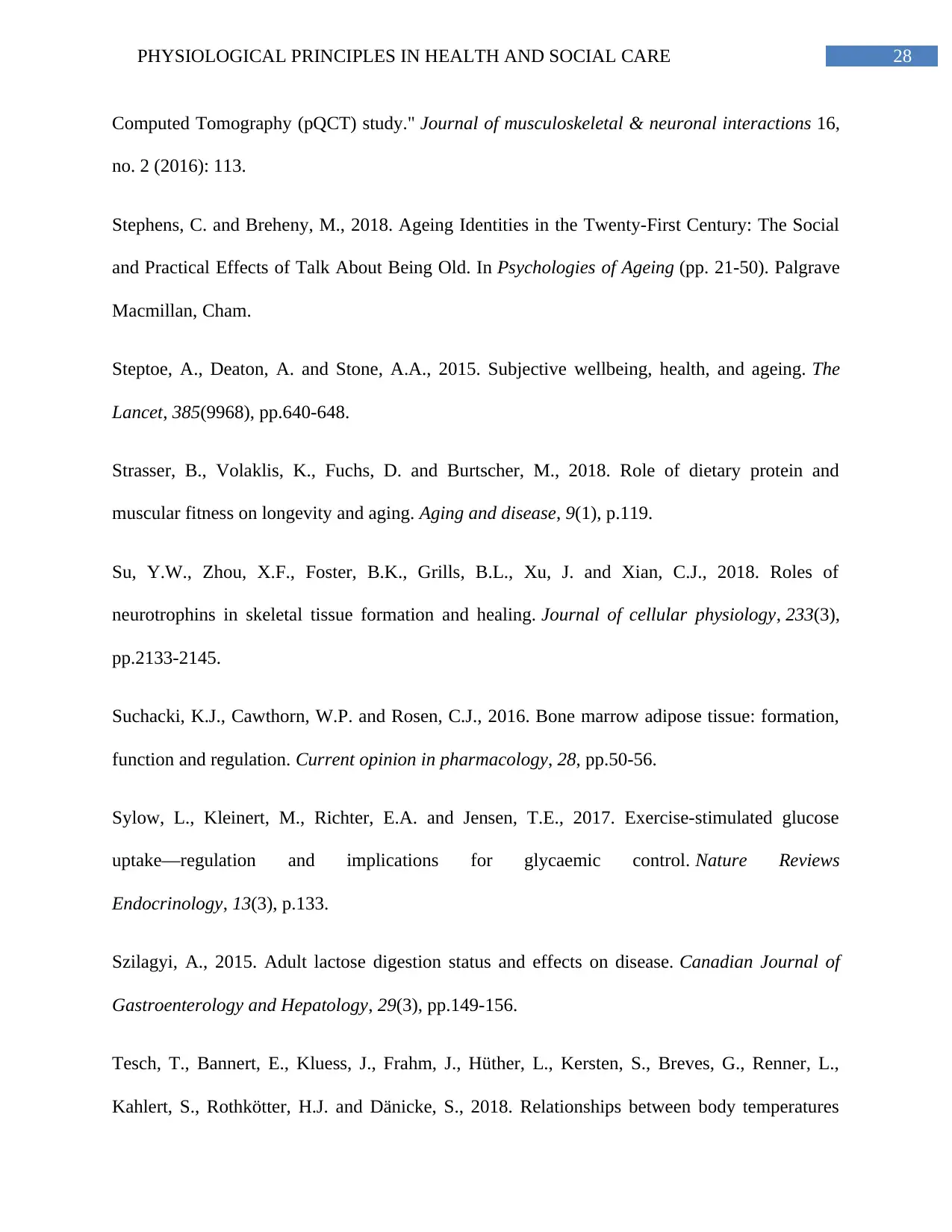
28PHYSIOLOGICAL PRINCIPLES IN HEALTH AND SOCIAL CARE
Computed Tomography (pQCT) study." Journal of musculoskeletal & neuronal interactions 16,
no. 2 (2016): 113.
Stephens, C. and Breheny, M., 2018. Ageing Identities in the Twenty-First Century: The Social
and Practical Effects of Talk About Being Old. In Psychologies of Ageing (pp. 21-50). Palgrave
Macmillan, Cham.
Steptoe, A., Deaton, A. and Stone, A.A., 2015. Subjective wellbeing, health, and ageing. The
Lancet, 385(9968), pp.640-648.
Strasser, B., Volaklis, K., Fuchs, D. and Burtscher, M., 2018. Role of dietary protein and
muscular fitness on longevity and aging. Aging and disease, 9(1), p.119.
Su, Y.W., Zhou, X.F., Foster, B.K., Grills, B.L., Xu, J. and Xian, C.J., 2018. Roles of
neurotrophins in skeletal tissue formation and healing. Journal of cellular physiology, 233(3),
pp.2133-2145.
Suchacki, K.J., Cawthorn, W.P. and Rosen, C.J., 2016. Bone marrow adipose tissue: formation,
function and regulation. Current opinion in pharmacology, 28, pp.50-56.
Sylow, L., Kleinert, M., Richter, E.A. and Jensen, T.E., 2017. Exercise-stimulated glucose
uptake—regulation and implications for glycaemic control. Nature Reviews
Endocrinology, 13(3), p.133.
Szilagyi, A., 2015. Adult lactose digestion status and effects on disease. Canadian Journal of
Gastroenterology and Hepatology, 29(3), pp.149-156.
Tesch, T., Bannert, E., Kluess, J., Frahm, J., Hüther, L., Kersten, S., Breves, G., Renner, L.,
Kahlert, S., Rothkötter, H.J. and Dänicke, S., 2018. Relationships between body temperatures
Computed Tomography (pQCT) study." Journal of musculoskeletal & neuronal interactions 16,
no. 2 (2016): 113.
Stephens, C. and Breheny, M., 2018. Ageing Identities in the Twenty-First Century: The Social
and Practical Effects of Talk About Being Old. In Psychologies of Ageing (pp. 21-50). Palgrave
Macmillan, Cham.
Steptoe, A., Deaton, A. and Stone, A.A., 2015. Subjective wellbeing, health, and ageing. The
Lancet, 385(9968), pp.640-648.
Strasser, B., Volaklis, K., Fuchs, D. and Burtscher, M., 2018. Role of dietary protein and
muscular fitness on longevity and aging. Aging and disease, 9(1), p.119.
Su, Y.W., Zhou, X.F., Foster, B.K., Grills, B.L., Xu, J. and Xian, C.J., 2018. Roles of
neurotrophins in skeletal tissue formation and healing. Journal of cellular physiology, 233(3),
pp.2133-2145.
Suchacki, K.J., Cawthorn, W.P. and Rosen, C.J., 2016. Bone marrow adipose tissue: formation,
function and regulation. Current opinion in pharmacology, 28, pp.50-56.
Sylow, L., Kleinert, M., Richter, E.A. and Jensen, T.E., 2017. Exercise-stimulated glucose
uptake—regulation and implications for glycaemic control. Nature Reviews
Endocrinology, 13(3), p.133.
Szilagyi, A., 2015. Adult lactose digestion status and effects on disease. Canadian Journal of
Gastroenterology and Hepatology, 29(3), pp.149-156.
Tesch, T., Bannert, E., Kluess, J., Frahm, J., Hüther, L., Kersten, S., Breves, G., Renner, L.,
Kahlert, S., Rothkötter, H.J. and Dänicke, S., 2018. Relationships between body temperatures
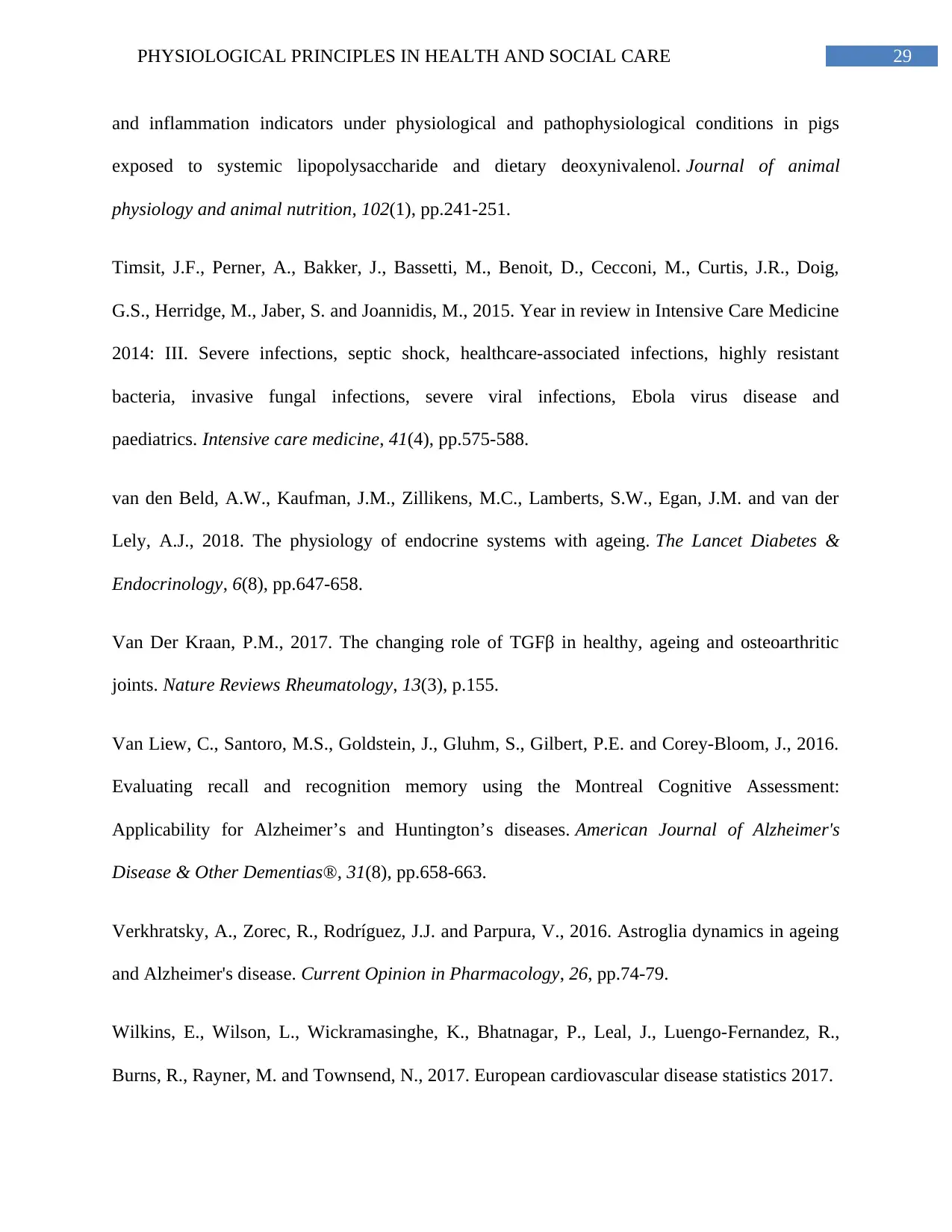
29PHYSIOLOGICAL PRINCIPLES IN HEALTH AND SOCIAL CARE
and inflammation indicators under physiological and pathophysiological conditions in pigs
exposed to systemic lipopolysaccharide and dietary deoxynivalenol. Journal of animal
physiology and animal nutrition, 102(1), pp.241-251.
Timsit, J.F., Perner, A., Bakker, J., Bassetti, M., Benoit, D., Cecconi, M., Curtis, J.R., Doig,
G.S., Herridge, M., Jaber, S. and Joannidis, M., 2015. Year in review in Intensive Care Medicine
2014: III. Severe infections, septic shock, healthcare-associated infections, highly resistant
bacteria, invasive fungal infections, severe viral infections, Ebola virus disease and
paediatrics. Intensive care medicine, 41(4), pp.575-588.
van den Beld, A.W., Kaufman, J.M., Zillikens, M.C., Lamberts, S.W., Egan, J.M. and van der
Lely, A.J., 2018. The physiology of endocrine systems with ageing. The Lancet Diabetes &
Endocrinology, 6(8), pp.647-658.
Van Der Kraan, P.M., 2017. The changing role of TGFβ in healthy, ageing and osteoarthritic
joints. Nature Reviews Rheumatology, 13(3), p.155.
Van Liew, C., Santoro, M.S., Goldstein, J., Gluhm, S., Gilbert, P.E. and Corey-Bloom, J., 2016.
Evaluating recall and recognition memory using the Montreal Cognitive Assessment:
Applicability for Alzheimer’s and Huntington’s diseases. American Journal of Alzheimer's
Disease & Other Dementias®, 31(8), pp.658-663.
Verkhratsky, A., Zorec, R., Rodríguez, J.J. and Parpura, V., 2016. Astroglia dynamics in ageing
and Alzheimer's disease. Current Opinion in Pharmacology, 26, pp.74-79.
Wilkins, E., Wilson, L., Wickramasinghe, K., Bhatnagar, P., Leal, J., Luengo-Fernandez, R.,
Burns, R., Rayner, M. and Townsend, N., 2017. European cardiovascular disease statistics 2017.
and inflammation indicators under physiological and pathophysiological conditions in pigs
exposed to systemic lipopolysaccharide and dietary deoxynivalenol. Journal of animal
physiology and animal nutrition, 102(1), pp.241-251.
Timsit, J.F., Perner, A., Bakker, J., Bassetti, M., Benoit, D., Cecconi, M., Curtis, J.R., Doig,
G.S., Herridge, M., Jaber, S. and Joannidis, M., 2015. Year in review in Intensive Care Medicine
2014: III. Severe infections, septic shock, healthcare-associated infections, highly resistant
bacteria, invasive fungal infections, severe viral infections, Ebola virus disease and
paediatrics. Intensive care medicine, 41(4), pp.575-588.
van den Beld, A.W., Kaufman, J.M., Zillikens, M.C., Lamberts, S.W., Egan, J.M. and van der
Lely, A.J., 2018. The physiology of endocrine systems with ageing. The Lancet Diabetes &
Endocrinology, 6(8), pp.647-658.
Van Der Kraan, P.M., 2017. The changing role of TGFβ in healthy, ageing and osteoarthritic
joints. Nature Reviews Rheumatology, 13(3), p.155.
Van Liew, C., Santoro, M.S., Goldstein, J., Gluhm, S., Gilbert, P.E. and Corey-Bloom, J., 2016.
Evaluating recall and recognition memory using the Montreal Cognitive Assessment:
Applicability for Alzheimer’s and Huntington’s diseases. American Journal of Alzheimer's
Disease & Other Dementias®, 31(8), pp.658-663.
Verkhratsky, A., Zorec, R., Rodríguez, J.J. and Parpura, V., 2016. Astroglia dynamics in ageing
and Alzheimer's disease. Current Opinion in Pharmacology, 26, pp.74-79.
Wilkins, E., Wilson, L., Wickramasinghe, K., Bhatnagar, P., Leal, J., Luengo-Fernandez, R.,
Burns, R., Rayner, M. and Townsend, N., 2017. European cardiovascular disease statistics 2017.
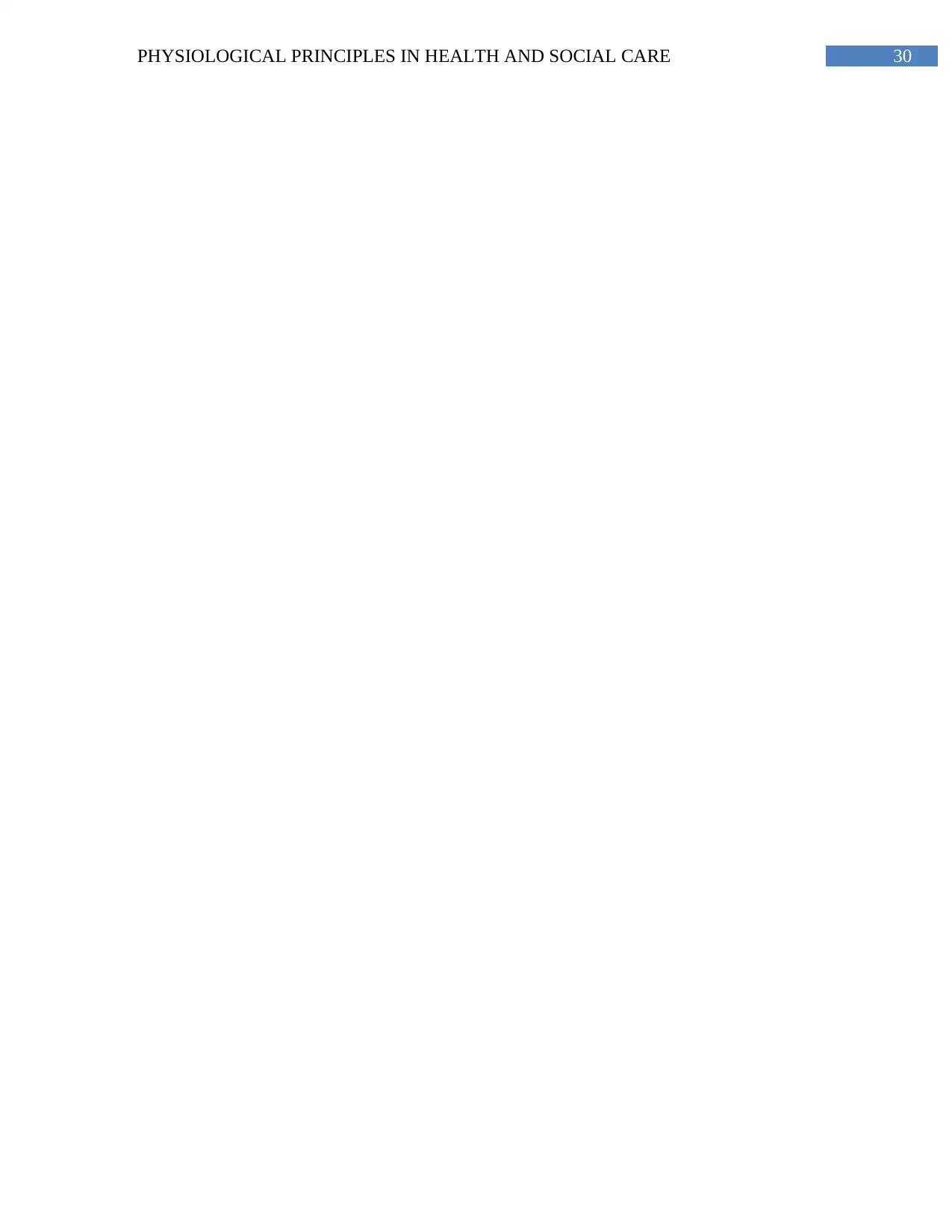
30PHYSIOLOGICAL PRINCIPLES IN HEALTH AND SOCIAL CARE
Paraphrase This Document
Need a fresh take? Get an instant paraphrase of this document with our AI Paraphraser
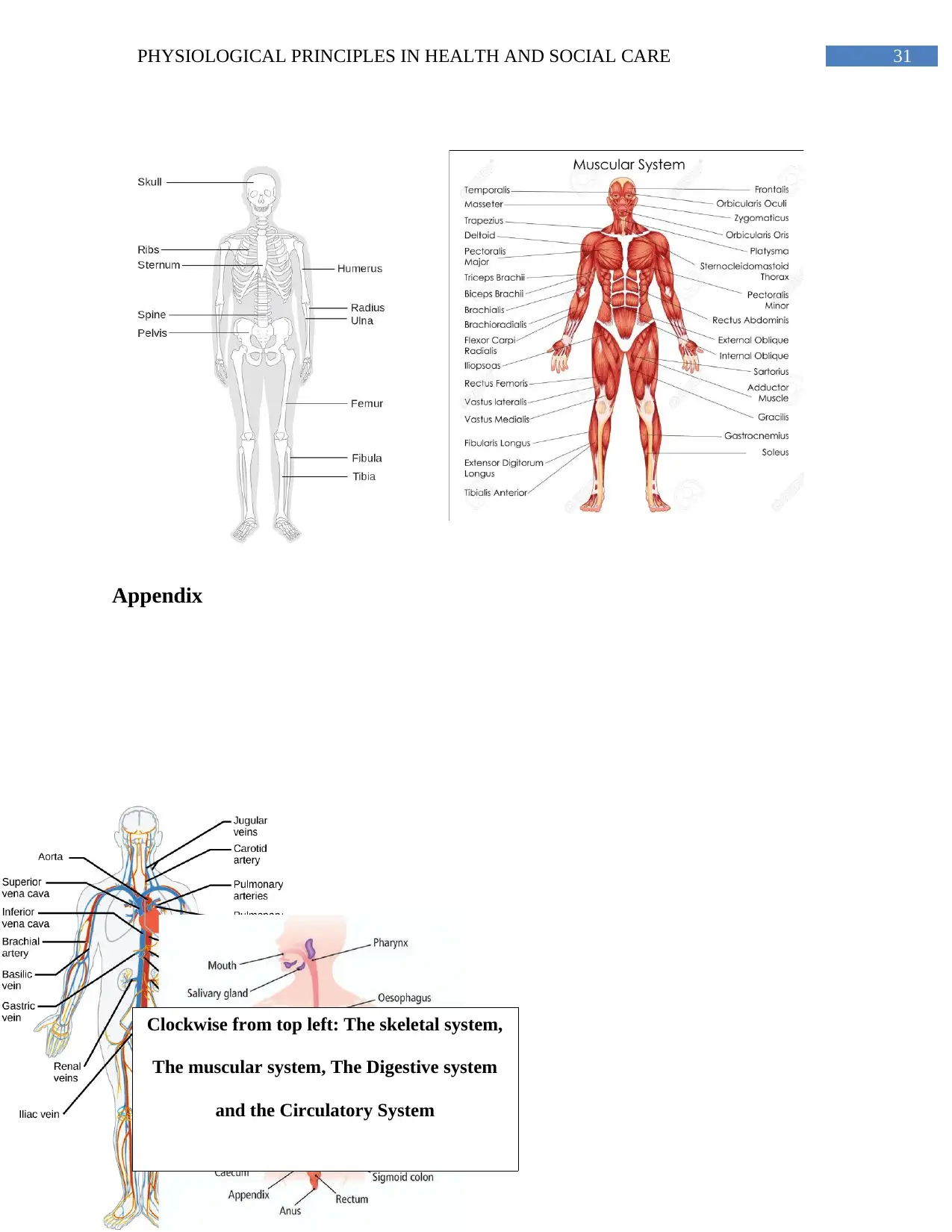
31PHYSIOLOGICAL PRINCIPLES IN HEALTH AND SOCIAL CARE
Appendix
Clockwise from top left: The skeletal system,
The muscular system, The Digestive system
and the Circulatory System
Appendix
Clockwise from top left: The skeletal system,
The muscular system, The Digestive system
and the Circulatory System
1 out of 32
Related Documents
Your All-in-One AI-Powered Toolkit for Academic Success.
+13062052269
info@desklib.com
Available 24*7 on WhatsApp / Email
![[object Object]](/_next/static/media/star-bottom.7253800d.svg)
Unlock your academic potential
© 2024 | Zucol Services PVT LTD | All rights reserved.
![[SOLVED] Understanding Joint Health and Mobility](/_next/image/?url=https%3A%2F%2Fdesklib.com%2Fmedia%2Fimages%2Fgf%2F2670f52b0e46412e821bb4c2146b7256.jpg&w=256&q=75)



